MITCHEL, EDWIN WILLIAM (1838-1873). Captain and assistant quartermaster, United States Volunteers Quartermaster’s Department; second lieutenant, 4th Ohio Cavalry. Originally from Ohio, he and his brother, Frederick Augustus (see), and father, Ormsby McKnight Mitchel (see), served together for part of the Civil War. He enlisted as a second lieutenant on January 11, 1862, and was commissioned into the Field and Staff of the 4th Ohio that same day. Upon his promotion to captain and assistant quartermaster on June 9, 1862, he was commissioned into the United States Volunteers Quartermaster’s Department where he served as a brigade quartermaster on his father’s staff. Along with his brother, Frederick, he was with his father when he died. He resigned on December 6, 1862. His last residence was in Bloomfield, New Jersey. Section 149, lot 13045.
Civil War Bio Search
MITCHEL, FREDERICK AUGUSTUS (1839-1918). Captain and aide-de-camp, United States Volunteers; second lieutenant, 21st New York Infantry, Company A; 16th Infantry, United States Army. A native of Cincinnati, Ohio, Mitchel was the son of Ormsby McKnight Mitchel (see) and brother of Edwin William Mitchel (see). As per the Semicentennial Biographical Catalogue of the Zeta Psi Fraternity, he was educated in Cincinnati and then at Brown from 1856-60. During the Civil War, Mitchel enlisted as a second lieutenant on August 27, 1861, at Washington, D.C., was commissioned into the 21st New York that same day and served there until he was discharged for promotion to captain and aide-de-camp of United States Volunteers on September 3, 1862. Serving with his father, he was with him in South Carolina when he died, and left Volunteers when his term expired on November 7 of that year. He was commissioned into the 16th Infantry of the United States Army as a second lieutenant on March 25, 1863, and resigned on August 17, 1863.
In 1881, his application for an invalid pension was approved, certificate 1,072,709. The Zeta Psi biographical sketch and The Reader’s Dictionary of Authors (H. M. Ayres, ed., 1917) indicate that Mitchel was a novelist and biographer. Among his works were an account about his father, Ormsby McKnight Mitchel, Astronomer and General, a Biographical Narrative (1887) and Chattanooga (1891) and Chickamauga (1892), two romances of the American Civil War. Mitchel also wrote magazine articles. One for Lippincott’s titled Confessions of an Aide-de-Camp, was described as a “rattling tale” of the Civil War in which the hero and heroine have surprising adventures. An article in the Courier-News (Bridgewater, New Jersey) on May 29, 1896 (just before Decoration Day), noted that General O. M. Mitchel’s burial place was at Green-Wood Cemetery in Brooklyn and that F. A. Mitchel was interested in the care of the grave.
He was living in East Orange, New Jersey, and working as an author at the time of the census of 1900. When he applied for a passport in 1909, he indicated that he pursued the occupation of literature. He was 5′ 4″ tall with brown eyes, a Roman nose, grizzled gray hair, a square forehead, narrow mouth, pointed chin, and small and narrow face. The 1916 Orange, New Jersey City Directory lists Mitchel as a writer. He last lived at 140 Prospect Street in East Orange, New Jersey. His causes of death are listed as endocarditis and arteriosclerosis. Shortly after his death in 1918, Maria G. Mitchel applied for a widow’s pension that was granted under certificate 870,000. Section 149, lot 13045.
MITCHEL, ORMSBY McKNIGHT (1810-1862). Major general, Department of the South; brigadier general, United States Volunteers; Department and Army of Ohio and Cumberland. Born in Morganfield, Kentucky, his family relocated to Ohio after his father’s death. Mitchel was a 1829 graduate of the United States Military Academy at West Point (ranking 15 in a class of 46), and served as assistant professor of mathematics there from August 30, 1829, through August 28, 1831. After serving on garrison duty until September 30, 1832, he resigned, was admitted to the bar, practiced law for two years in Cincinnati, Ohio, was chief engineer of the Little Miami Railroad, 1836-37, and professor of mathematics, astronomy and philosophy at Cincinnati College, 1834-44. During his time as a professor, he traveled to Munich, Germany, in 1842 where he procured a 12 inch glass for an equatorial telescope, then studied at the Greenwich Observatory in England before heading back to the United States. A renowned lecturer of astronomy whose personal magnetism helped fuel an interest in his subject to all audiences, he was instrumental in building the refractory telescope in Cincinnati and helped establish the Dudley Observatory in Albany, the Naval Observatory, and the Harvard Observatory. A member of various scientific associations, he wrote Popular Astronomy in 1860.
At the start of the Civil War, Mitchel was commissioned brigadier general of United States Volunteers on August 9, 1861, and at first reported to General McClellan, who assigned him the command of General William B. Franklin’s brigade in the Army of the Potomac; but at the request of the citizens of Cincinnati he was transferred to that city and commanded the Department of the Ohio from September 19 to November 13, 1861. He served with the Army of the Ohio during the campaigns of the winter of 1861-62 in Tennessee and northern Alabama. He was engaged in the occupations of Bowling Green, Kentucky, and Nashville, Tennessee, the march to Huntsville, Alabama, the action near Bridgeport, Alabama, April 30, 1862, and was promoted major general of volunteers to date from April 11, 1862. He took possession of the railroad from Decatur to Stephenson, securing the control of northern Alabama to the Federal authorities. Eager to advance into the heart of the South, he was restrained by his superior officer, General Buell. As a result of his dispute with Buell, he tendered his resignation to the secretary of war and was transferred to the command of the Department of the South, headquartered at Hilton Head, South Carolina, as of September 17, 1862. In Hilton Head, the Union had liberated the sea islands and Ormsby gave the order freeing the enslaved people there and providing them with a land for a town and a plot on which they could grow crops.
According to Jack D. Welsh, M.D., in Medical Histories of Union Generals (1996, p. 232), the steamer Delaware, which had docked at Hilton Head on August 26, was quarantined there for ten days because of yellow fever in Key West, Florida, a port visited by the vessel. After members of the 7th New Hampshire, who were on the Delaware, were let ashore at Hilton Head, yellow fever broke out three days later in the camp. Mitchel contracted the disease on October 27, gave up his command, and died three days later at Beaufort, South Carolina. Two of his sons, Edwin William (see) and Frederick Augustus (see) served with him, and a third son, Ormsby McKnight Jr., was a 1865 West Point graduate who served with the 17th Infantry as an adjutant until 1867, then joined the 4th Artillery until 1871. His nickname in the Army, “Old Stars,” was a reference to his fascination with astronomy, an interest that is marked by a star on his gravestone. Originally interred at Beaufort, South Carolina, his remains were moved to Green-Wood on January 16, 1863. The inventor of the declinometer (an instrument for measuring magnetic angles) and other astronomical apparatus, his work, Astronomy of the Bible, was published in 1863, a year after his death. Section 149, lot 13045.
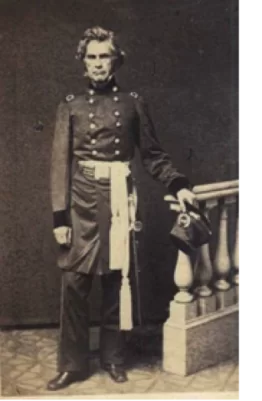
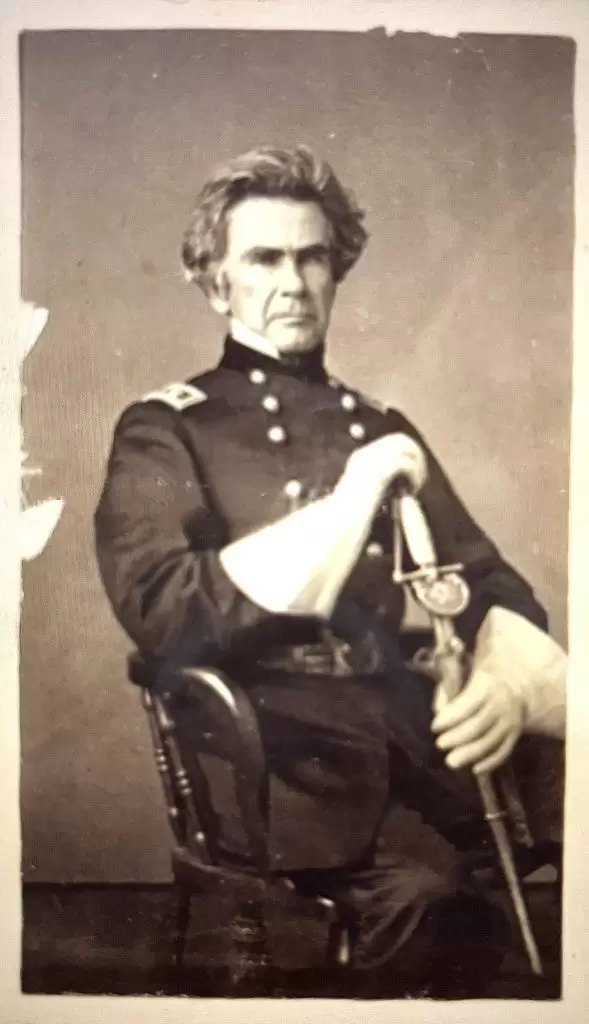
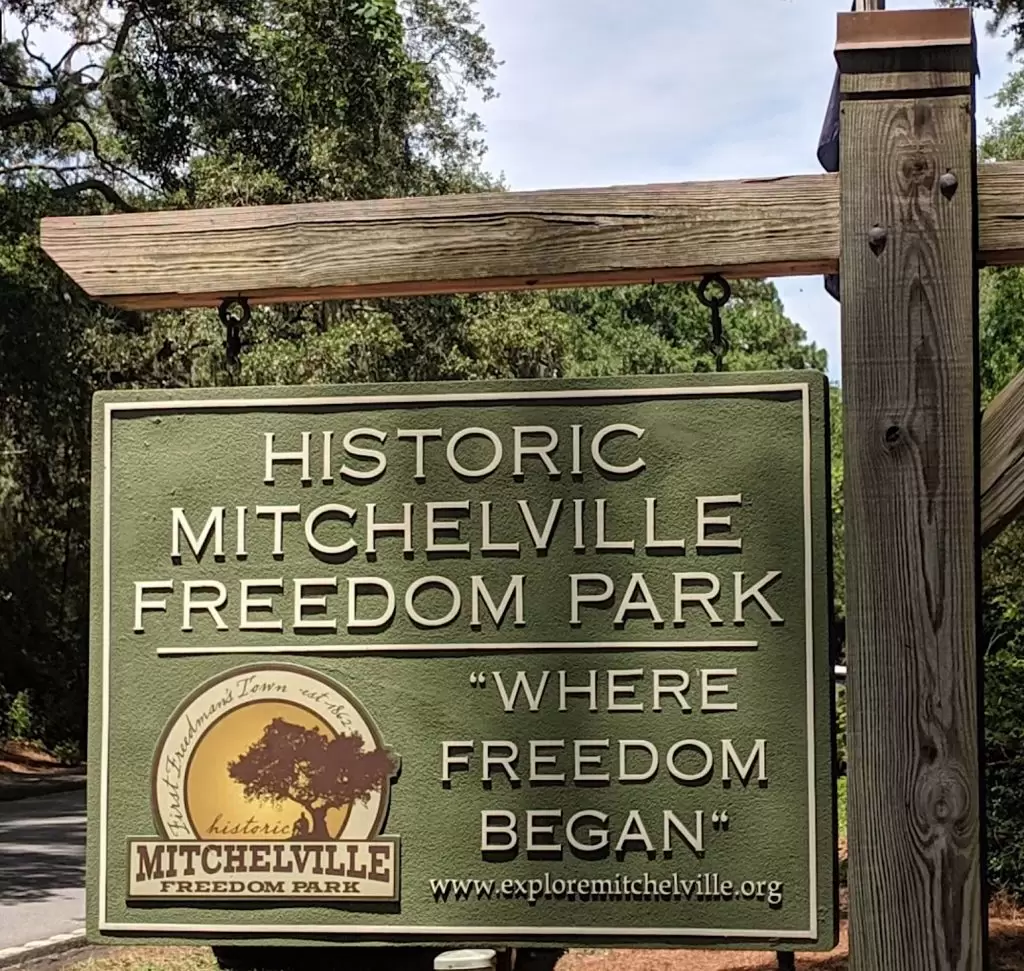

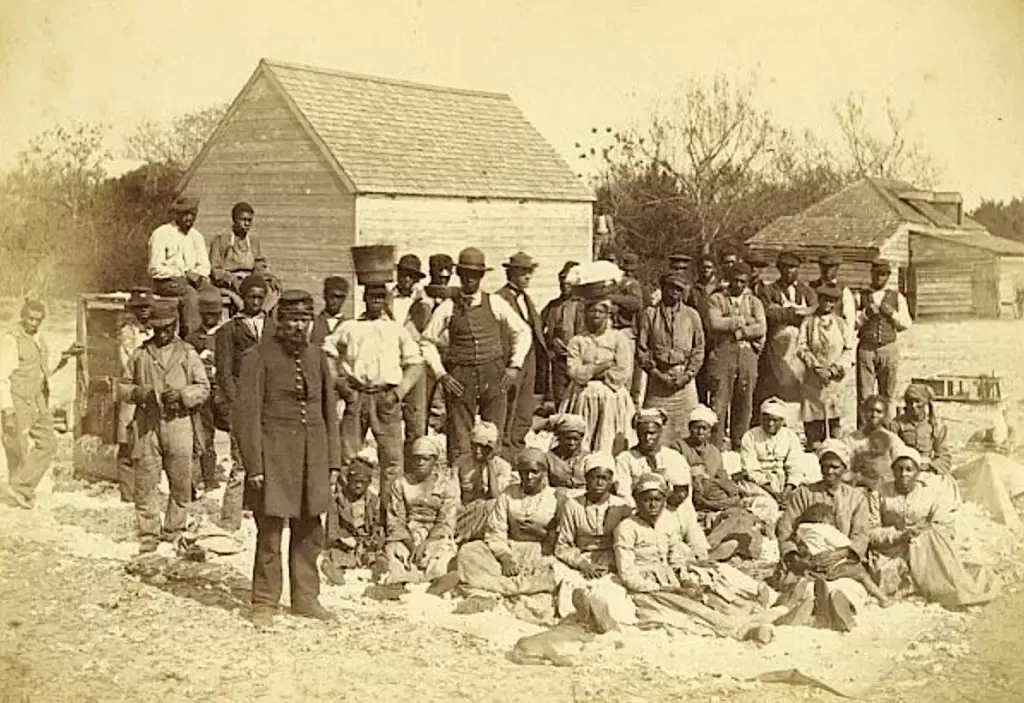
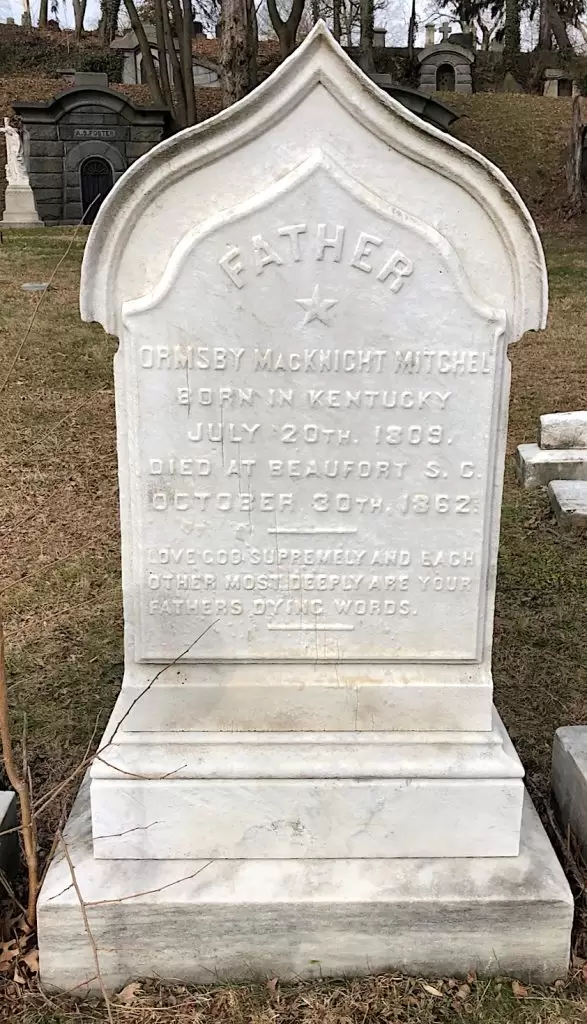

MITCHELL, AUGUSTUS (?-1863). Third assistant engineer, United States Navy. Mitchell first enlisted in the Navy as a third assistant engineer on July 1, 1861, and resigned on May 1, 1862. He re-enlisted as a third assistant engineer on October 6, 1862, and served aboard the USS Weehawken. That vessel, an iron-clad monitor, was commissioned at Jersey City, New Jersey, in mid-January 1863. Serving in Charleston Harbor, near Fort Sumter, South Carolina, on April 7, 1863, she was struck by over 50 enemy cannons. After repairs, she was in waters off Georgia and on June 17, 1863, and captured the CSS Atlanta and Confederate Major Reid Sanders (see) and Leslie King (see), a second assistant engineer. Returning to Charleston, South Carolina, the Weehawken assisted in the bombardments of Fort Wagner and Fort Sumter. After being grounded on September 7, she was repaired and became part of the blockade off Charleston that October. The Weehawken suddenly sunk in a gale while at anchor off Charleston on December 6. Four engineers who couldn’t escape the flood and 27 other crewmen perished. The Brooklyn Daily Eagle reported on this tragedy on December 12:
…That poor Monitor fleet, which went forth with colors flying, carrying the hopes of the nation with it, has met disaster at every turn, encountered obstacles and sustained repulse, been battered and bruised, and finally settled down at anchorage not far from Morris Island. Even here it has been pursued, and the winds of Heaven with the waves of the ocean have destroyed and pushed down from sight, one of its best and strongest, and most vaunted components.
There was much speculation as to the cause of the Weehawken’s sinking. One admiral attributed it to damage suffered while aground under fire of the Sullivan Island batteries that strained the rivets on its bottom plates. John Ericcson, who pioneered ironclad construction, attributed the sinking to water entering the anchor hoister hatch after it had been accidentally left open by a crew member. Ultimately, the inquiry concluded that a heavy load of ammunition, open hatches and a failure to level the ship after it had taken on water caused the sinking. Although crews attempted to bring up the Weehawken as early as December 1863, it took eight years before the ship and her crew members who perished there were brought back up. The remains of the men were then recovered and given proper burial.
The funeral ceremony was detailed in an article in The New York Times on September 27, 1871. As per that account, the pageant began at the Brooklyn Navy Yard when a small box, containing the bones of the four deceased men, was deposited into a beautiful rosewood casket decorated with silver. A large silver plate which was placed upon the casket read, “This coffin contains the remains of four officers of the United States Navy, attached to the Weehawken, which foundered off Charleston, S.C., Dec. 6, 1863: H. W. MERIDEN (sic), Third Assistant Engineer; AUGUSTUS MITCHELL, Third Assistant Engineer; GEORGE W. MCGOWAN, Acting Third Assistant Engineer; and CHARLES SPONBERG, Acting Third Assistant Engineer.” The funeral procession began at noon with a detachment from the Vermont playing Auld Lang Syne. The cortege was led by the Band, followed by a detachment of Marines, sailors from the Man-of-War, the casket flanked by pall-bearers, a delegation from the Freemasons, and friends and relatives. The detachment of marines fired the customary funeral volleys at the gravesite. The Times noted that rain fell during the cortege and graveside ceremony adding a note of solemnity to the occasion.
Henry W. Merian (see), Augustus Mitchell, George N. McGowan (see), and Charles Sponberg (see) are remembered in a monument at Green-Wood erected in 1871 and dedicated to their valiant efforts. The monument has a carving on its front that states it was erected by Frances Mitchell, who is likely the mother of Augustus Mitchell and who purchased the lot at Green-Wood for the burial of her son and his three comrades, and J. J. Merian, likely the father of Henry Merian. On one side the inscription reads: “SACRED TO THE MEMORY OF FOUR OFFICERS OF THE U.S. NAVY WHO LOST THEIR LIVES BY BEING DROWNED ON THE U.S. MONITOR WEEHAWKEN TO WHICH THEY WERE ATTACHED WHEN SHE FOUNDERED OFF CHARLESTON, S. C. DECEMBER 6, 1863.” The opposite side of the monument is inscribed: , “THE REMAINS WERE EXHUMED FROM THE ENGINE ROOM OF THE WRECKED MONITOR WHERE THEY NOBLY FELL AT THEIR POST OF DUTY. SEPTEMBER 26, 1871. Frances Mitchell, an English-born widow who last lived at 219 East 59th Street in Manhattan, was interred in the same lot as Augustus Mitchell on April 25, 1884. Section 82, lot 20207.
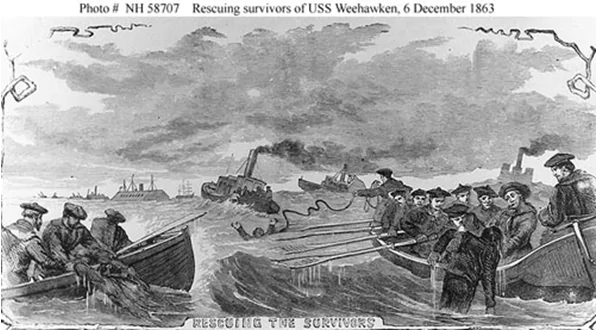
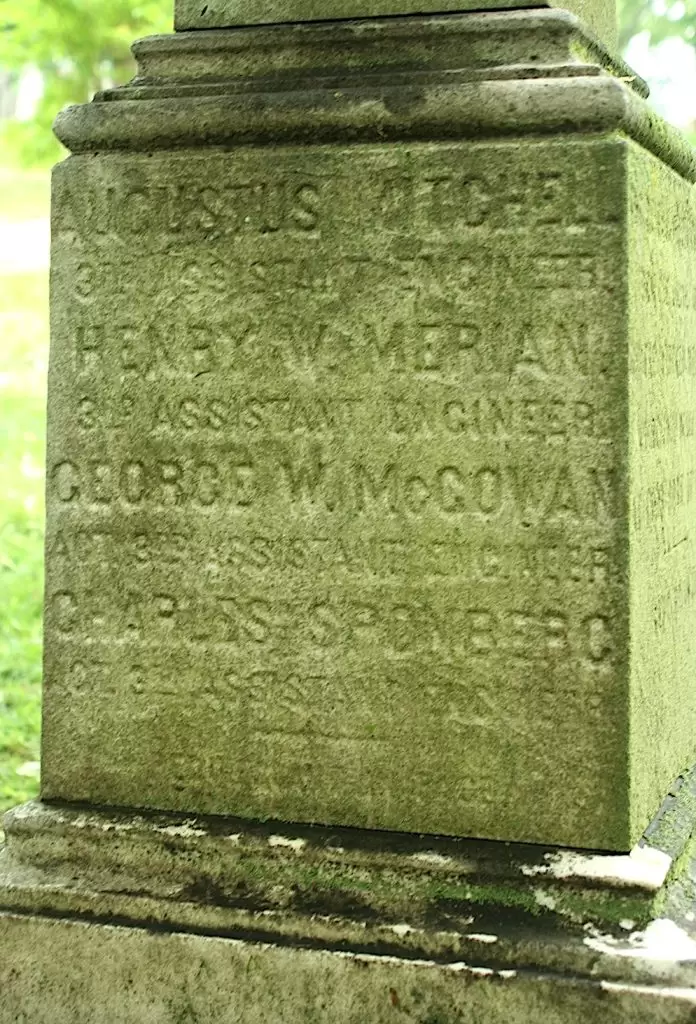
Inscription on the back of memorial: “The remains were exhumed from the Engine Room of the wrecked Monitor where they nobly fell at their post of duty.
MITCHELL, EDWARD LEWIS (1840-1862). Captain by brevet; first lieutenant, 16th Infantry, United States Army, Company F. A New Yorker by birth who resided at 782 Greenwich Avenue in Manhattan, Mitchell, a Columbia Law School student, enlisted as a first lieutenant on May 14, 1861, and was immediately commissioned into the 16th Infantry, United States Army. Captain Edwin F. Townsend of the 16th wrote a few days after the Battle of Shiloh from the battlefield of the heavy fighting on April 7th and Mitchell’s death: he “was instantly killed by a ball through the brain while delivering an order from me…” On April 7, 1862, the same day that Mitchell was killed in action, he was brevetted to captain “for gallantry and meritorious service at the Battle of Shiloh, Tennessee.” When he was transported to New York, he was mistakenly listed in the Bodies in Transit database as Edward Lewis. As per his obituary in the New York Daily Tribune, the funeral took place at the home of his father, John F. Mitchell, at 734 Greenwich Street; friends and family and the students and professors of Columbia Law School were invited to attend his funeral. He was interred at Green-Wood on May 5. On May 7, 1862, the New York Daily Tribune published this resolution from his law school classmates:
Whereas, Lieut. Edward L. Mitchell, late a member of the Senior Class in Columbia College Law School, was killed in the battle of Pittsburg Landing,
Resolved, That we respectfully offer to the friends and members of his family our deepest sympathy in their bereavement, trusting that his unselfish life, his strict regard for duty, and his devoted patriotism, may in some slight degree alleviate their sorrow.
Resolved, That the foregoing resolutions be published in the daily papers.
Although his mother, Ann Mitchell, applied for a survivor’s pension on May 9, 1895, application 613,850, it was never certified. Section 25, lot 2980.
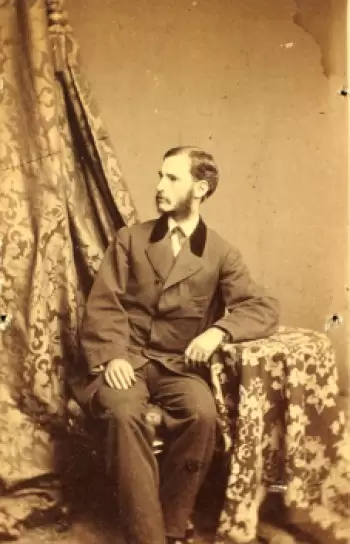
MITCHELL, PAUL (1841-1913). Musician, 12th Infantry, United States Army, Company I; private, 6th Regiment, New York State Militia, Company B. A native of Messina on Sicily in Italy, Mitchell immigrated to the United States in 1845. During the Civil War, he enlisted at New York City as a private on June 20, 1861, mustered into the 6th New York Militia ten days later, and was discharged after three months on October 15 at New York City. On November 29, 1861, Mitchell mustered into Company I of the 12th Infantry, United States Army, as a musician. He served in this unit until the end of the Civil War, was promoted to sergeant on April 4, 1867, and was discharged from military service on December 2, 1867.
In civilian life, he was a musician, composer and teacher. In civilian life, he was a musician, composer and teacher. His obituary in the Brooklyn Daily Eagle, which confirms his Civil War service and refers to him as “Professor Mitchell,” reports that he was a member of Gilmore’s, Conterno’s and Sousa’s bands, and was in the Park Theater orchestra during the management of Colonel Sinn. As per the census of 1880, Mitchell was living in Brooklyn and was employed as a music teacher. In 1890, his application for an invalid pension was granted, certificate 828,844. The censuses of 1900 and 1910 indicate that he was a music teacher and that he lived in Brooklyn. He became a member of the Brooklyn Grand Army of the Republic’s Winchester Post #197 in 1907. Among the other organizations to which he belonged were the Brooklyn Italian Mutual Benefit Society of which he had been a president at one time, the Long Island Council of the Royal Arcanum, the Musical Mutual Benefit Association, the Freemasons, and the Brooklyn Masonic Veterans Association. His last residence was 274 Van Buren Street in Brooklyn; he lived in Brooklyn for the last fifty-six years of his life. The Brooklyn Daily Eagle noted that he died after a lingering illness; members of the Brooklyn Masonic Veterans were invited to attend his funeral. Shortly after his death, Sarah Mitchell, who is interred with him, applied for and received a widow’s pension, certificate 756,717. Section 164, lot 15771, grave 2.
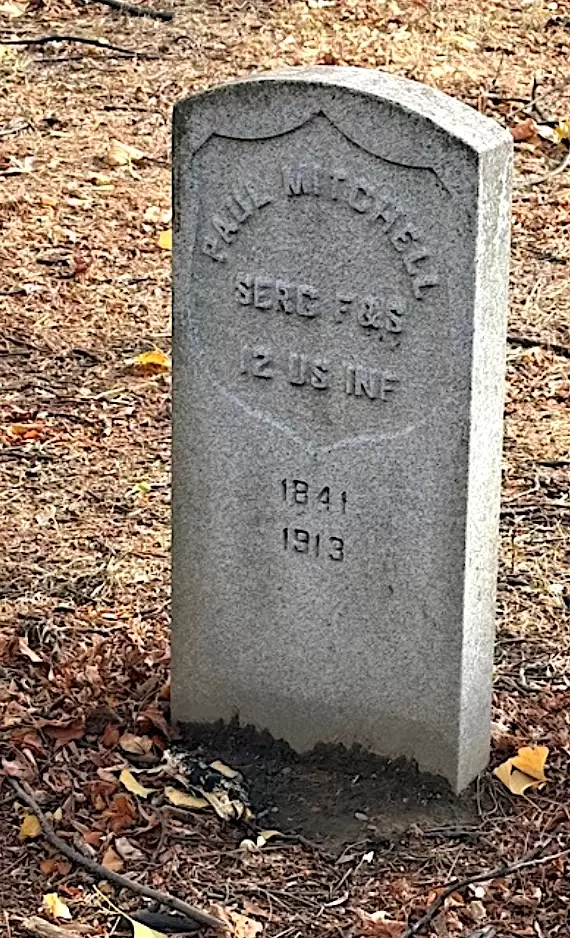
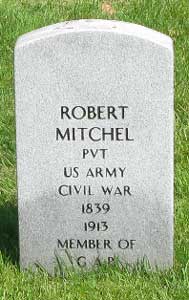
MITCHELL (or MITCHEL), ROBERT (1839-1913). Private, 14th New York Heavy Artillery, Company A. Originally from Ogdensburgh, New York, he enlisted there as a private on July 24, 1863, and mustered into the 14th Heavy Artillery on August 29. As per his muster roll, he was a painter who was 5′ 5 5/8″ tall with blue eyes, brown hair and a fair complexion. He was discharged on August 28, 1865, at New York City as Robert Mitchel.
The 1880 census lists him (Mitchel with one “l” in surname) as living in Brooklyn and employed as a printer and proofer; Mitchell (with two “ls” in surname) is listed as a printer living at 299 Hewes Street in Lain’s Brooklyn Directories of 1889 and 1897. The 1890 Veterans Schedule confirms Mitchell’s Civil War service. In 1904, his application for an invalid pension was approved, certificate 1,096,619. He became a member of the G.A.R.’s Ulysses S. Grant Post #327 in Brooklyn in 1910. He last resided at 5712 14th Avenue in Brooklyn. His death was attributed to “softening of the brain.” Section 173, lot 15637, grave 1.
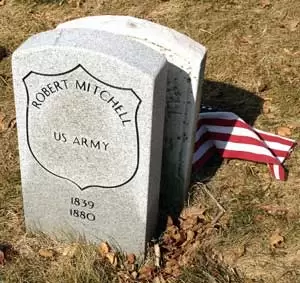
MITCHELL, ROBERT (1839-1880). Unknown soldier history. Born in Ireland, the specifics of his military career are unknown. He last resided in Brooklyn. Mitchell succumbed to nephritis. Section 115, lot 13536 (Soldiers’ Lot), grave 80.
MITCHELL, ROLAND GREENE (1841-1906). Private, 7th Regiment, New York State National Guard, Company K. Mitchell was born in New York State. As per his obituary in the Brooklyn Daily Eagle, he was a descendant of General Nathaniel Greene, who fought in the Revolutionary War, Providence Plantation-founder Roger Williams and Benedict Arnold, the second royal governor of Rhode Island. His great-grandfather, William Minturn, was a partner of Governor Gibbs of Newport, Rhode Island, and his grandfather, Henry Post, founded the shipping firm of Grinnell, Minturn & Company.
During the Civil War, Mitchell served with the 7th Regiment when it was activated for 30 days in 1863. Letters written by Mitchell appeared in Camp, Battle-Field and Prison by Lydia Minturn Post, published for the United States Sanitary Commission (Bunce & Huntington, Publishers) in 1865. One letter, written from Baltimore on March 11, 1862, describes his impression of the CSS Merrimac; the letter was written two days after the Battle of Hampton Roads. Considering the date of the letter, he may also have served in the 7th Regiment in 1862. He wrote, in part:
…But where is the Merrimac? Directly before us we saw something that looked very much like the peaked roof of a house drifting silently across the bay, and this was the famed craft. Its singular appearance-its still progress- its gloomy blackness, impressed one with a feeling of awe, and one forgot that it was fashioned by hands, and thought it some terrible monster, whose dread power none could foretell.
…With what intense interest we watched the ensuing conflict, you well can imagine.
How at first a belt of fire flashing ‘long the broadside; then dark sulphurous clouds eddied slowly away; and then, so quickly following, the rumbling roar of the explosion would come booming over the water.
How the balls went skipping over the bay, wide of the mark, sending sparkling jets high into the air.
How, when a better range was obtained, shot aimed point blank at the Merrimac, glancing from her sloping side, dashed the water into foam almost a right-angle from the direction in which it was fired.
How, as the firing became more and more rapid, the volume of sound swelled momentarily, until the ground trembled under our feet with the intermingling concussions.
And then how, when the shades of evening gathered round us, the view grew very grand, for at every discharge there issued from the vessel a sheet of flame—a perfect torrent of fire.
Truly it was a gallant sight, once seen never to be forgotten!
As the day wore on, however, the affair became more tragic, and sorrowfully we heard the sinking [USS] Cumberland fire her last shot at the foe, and saw the white flag flutter on the mast of the [USS] Congress.
At last the Merrimac drew off, and delivering a parting shot, moved slowly away.
Thus ended an engagement that has no precedent in history, and from which dates a new era in naval warfare. Long will its stirring scenes live in story and in song.
He wrote from the Baltimore Club-house in July of 1863:
You will, doubtless, be surprised when you see the stamp upon this paper. This morning our company was ordered to “pack up,” and get ourselves in marching order. We were marched into this city to take possession of the Maryland Club-house, which has been seized by the order of General Schenck. So here we are, having full possession of a most splendid house, furnished luxuriously, and situated in the most fashionable part of the town. Our sentries at the front-door sit in splendidly carved chairs, and the rest of us pass in and out at our pleasure. We are having a most enjoyable time, though I think it will be short lived, as we expect to return in a few days.
They have got up a story here, within a few hours, that the expelled members are going to try to retake their club-house, so we have to keep a strong guard. In looking over the visitor’s book, I see numerous names, even as late as the beginning of the week with C.S.A. and C.S.N. opposite, written in full; also the name of the one who introduced them to the club.
I am writing on a large library table, around which we are gathered, some ten or twelve fellows, while the rest are playing billiards in a room adjoining, which contains three fine tables—so you see we have some relaxation to “temper the stern realities of war.”
The census of 1880 indicates that he lived in Great Neck; no occupation is listed. An article in The New York Times on July 5, 1882, reported that his three-story candle factory at First Avenue and 4th Street was destroyed in a major fire. The article said that it is likely that a firecracker, thrown by a mischief-maker, started the conflagration; neighbors were unhappy about the noxious fumes that had emanated from the factory for a decade. Eleven engine companies reported to the scene of the conflagration. It was estimated that 20,000 people watched the scene on the Fourth of July. The article noted that the losses were most likely in the $80,000-$85,000 range; of that, the loss to the property was $25,000. After the fire was put out, there were an estimated 250-350 tons of tallow floating on the water; the estimate of the loss of this salvage was one to three cents per pound. This was the second major fire to the factory; a previous fire had occurred twenty years earlier. The 1883 and 1888 New York City Directories report that he was in the candle business at 141 Water Street; his home was 8 West 19th Street in Manhattan. His died at his country residence, Wildwood, in Great Neck, Long Island. As per his obituary in the New York Herald, he died from pneumonia. His funeral took place at the Church of the Ascension at Fifth Avenue and 10th Street in Manhattan. Section 139, lot 26623.
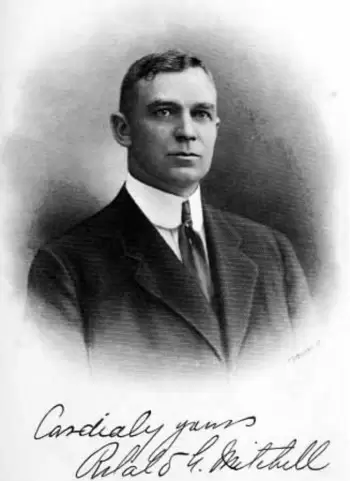
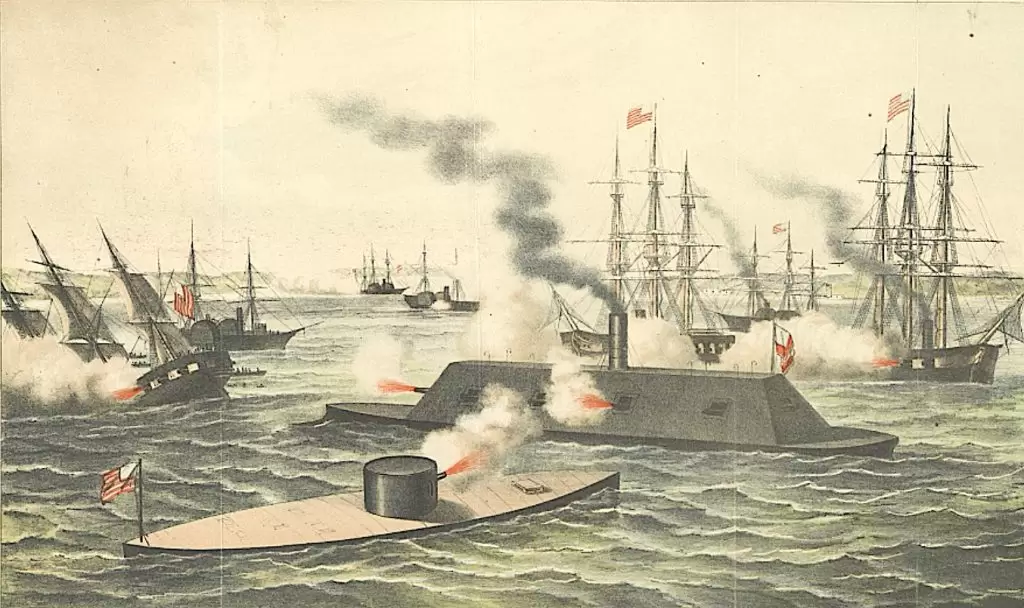
MITCHILL, JOHN GREENOAK (1840-1911). First lieutenant, 101st New York Infantry, Company D; private, 71st Regiment, New York State Militia, Company A. Mitchill was born in New York City. After serving three months in the 71st Regiment’s State Militia in 1861, he re-enlisted on November 1, 1861, at Hancock, New York, as a first lieutenant, and was commissioned into the 101st New York that same day. He was 5′ 9″ tall with blue eyes. Mitchill saw action in Virginia at the Battles of Oak Grove, White Oak Swamp, Savage’s Station, Glendale and Malvern Hill. He was discharged for disability on September 9, 1862, due to sciatica.
His pension index card, which uses the spelling “Mitchell,” reports that his application for an invalid pension was approved in 1880, certificate 858,694. The 1880 census notes that he was living in Brooklyn and working as a clerk in an oil refinery; the Brooklyn Directory for 1888 lists him as a clerk. He was living in Staten Island at the time of the 1900 and 1910 censuses. His last address was 109 St. Marks Place in Staten Island. An identification disc for Mitchill (below) is included in Identification Discs of Union Soldiers in the Civil War: A Complete Classification Guide and Illustrated History by Larry B. Maier and Joseph W. Stahl (2009). Section 95, lot 2634, grave 3.
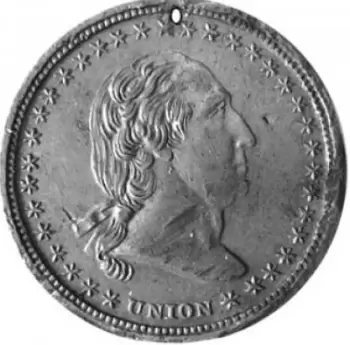
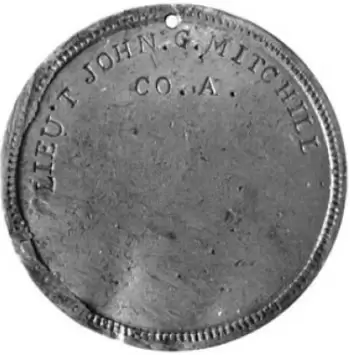
MITCHILL (or MITCHELL), JR., SAMUEL LATHAM (1833-1881). Major, 101st New York Infantry, Company D. A New York City native, Mitchill graduated from Columbia University, class of 1852. A news article about his commencement, which included his name as a recipient of a Bachelor of Arts degree, appeared in the Brooklyn Daily Eagle on July 29, 1852. He and his father, who had the same name and is interred in the same lot, owned a side-wheel steamship company. An ad from their company is below.
During the Civil War, he enlisted as a captain at Hancock, New York, on October 27, 1861, and was commissioned into Company D of the 101st New York on that day. As per his muster roll, he was a merchant who was 5′ 10″ tall with gray eyes, black hair and a dark complexion. His muster roll indicates that he was also borne on the rolls as Mitchell. On November 11, 1862, he was promoted to the rank of major and transferred to the Field and Staff. He mustered out the next month on December 24 when his regiment was consolidated. Mitchill’s passport application of January 1863 added further details to his physical description. He noted that he was 5′ 10½” tall with a high forehead, oval face, medium mouth, regular nose and square chin. The 1867 New York City Directory and the 1880 census report that he was a merchant. He last lived at 202 West 34th Street, New York City. The cause of his death was phthisis. As per his obituary in the New York Herald, his funeral was held at the house of his mother at 56 West 56th Street in Manhattan. Section 66, lot 1029.
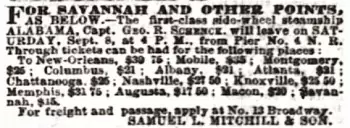
MITTNACHT, DANIEL (1842-1877). First lieutenant, 62nd New York Infantry, Companies E, C, and F. Born in New York City, he was living there at the time of the census of 1850. During the Civil War, Mittnacht enlisted at New York City as a private on May 15, 1861, mustered into Company E of the 62nd New York on July 3, and transferred to Company C on July 15. As per his muster roll, he was a compositor who was 5′ 7″ tall with gray eyes, dark hair and a fair complexion. On November 2, 1861, he was promoted to corporal of his company and was subsequently promoted to sergeant on October 20, 1862. After re-enlisting on January 1, 1864, he was wounded in action at the Battle of Petersburg, Virginia, on June 18, 1864. He received a promotion to first sergeant on July 10, 1864. On May 17, 1865, he was commissioned as a first lieutenant effective upon his transfer into Company F on June 20. Mittnacht mustered out on August 30, 1865, at Fort Schuyler, New York Harbor.
He is listed as a printer on the census of 1870. In 1876, his application for an invalid pension was approved under certificate 143,971. Mittnacht’s last residence was 85 Varick Street, Manhattan. He succumbed to consumption. In 1882, John Fincken, guardian, applied for a pension for a minor, application 290,581, but it was not certified.
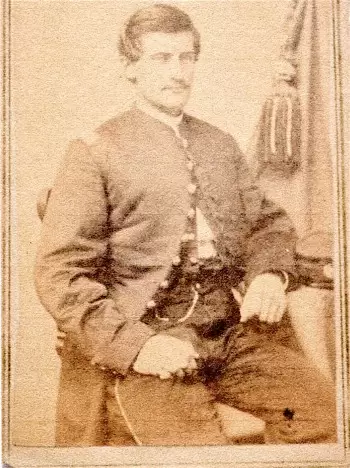
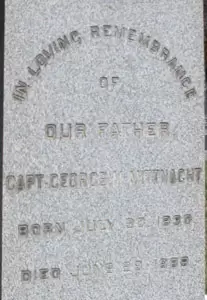
MITTNACHT, GEORGE M. (1830-1889). Captain, 6th Regiment, New York State Militia, Company E; 103rd New York Infantry, Company H. Born in Bavaria, Germany, Mittnacht immigrated to the United States in 1849. His obituary in his local newspaper, the Newtown Register, indicates that he arrived in this country in the same period as other German political refugees including Generals Franz Sigel and Carl Schurz. That obituary also reports that Mittnacht joined the 11th Regiment, New York State Militia, in 1855.
During the Civil War, he served with both the 6th and 103rd Regiments. He was commissioned into the 6th Regiment as a captain on April 19, 1861, and mustered out after three months on July 31, 1861. He then re-enlisted on February 19, 1862, was commissioned into the 103rd New York, also known as the Seward Infantry, and was discharged on June 30, 1862. He returned to the 6th on June 22, 1863, when it was part of the New York State National Guard, was commissioned into Company E, and mustered out after 30 days on July 22, 1863.
In civilian life, Mittnacht was in the safe and iron business on Spring Street in Manhattan; he remained active in the business for forty years. He is listed as a safe manufacturer at the time of the census of 1870 at which time he lived in New York City; the 1874 New York City Directory also lists him in the safe business. The 1880 census and the 1888 New York City Directory note that he was a resident of Long Island City and was a safe manufacturer. An article in The New York Times on March 31, 1882, describes a failed attempt by burglars to open a safe in Mittnacht’s factory at 24 Spring Street. Hook & Ladder Co. #9 was called to the scene because of smoke emanating from a smoldering pile of wood near the safes. When the police questioned Mittnacht, he refused to give any information about the break-in. The motive for the fire, which had been quickly extinguished, was never determined. A Letter to the Editor written by George M. Mittnacht, which he signed as late captain of Company H, was published in The New York Times on December 2, 1883, to correct and clarify the history of the 103rd New York Regiment. The major part of his letter follows:
The statement in your issue of Nov. 25 about the Colonel of the One Hundred and Third New York Volunteers is an error. We never had Charles Miller or A. J. B. Miller (who appears on the roll of the One Hundred and Third as a sergeant) as a Colonel. The regiment was raised after the expiration of the time of service of the Sixth Regiment, New York State Militia, about the latter part of 1861, from officers and men of the Sixth Regiment—namely Capt. C. Schneider, George M. Mittnacht…
The regiment, or rather a part of it, re-enlisted during the war, under Capt. William Redlich and was mustered out in 1865. While under Capt. Redlich’s command the regiment never was up to the requisite number to grant Capt. Redlich a promotion. Capt. Redlich was Sergeant of Company H (my company) when the regiment left New York. It was owing to his good deeds and name that the remnant of the regiment was not consolidated with other regiments and we have to thank him that the regiment was brought home with its original name—Seward Infantry, One hundred and Third New York Volunteers—of which we have all reason to be proud.
His last residence was 57 Camelia Street in Astoria, New York. The cause of his death was Bright’s disease. As per Mittnacht’s obituary in the New York Herald, which confirms his Civil War service, news of his death was sent to Maryland newspapers; his wife Mary, who is interred with him, was born Maryland. His gravestone is inscribed with his service as captain. Section 163, lot 14715, graves 7, 8, 9, 12, 13, 14.
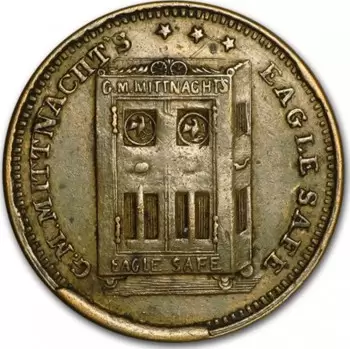
MIX, EUGENE (1841-1910). Private, 7th Regiment, New York State Militia, Company B. Mix, who was born in New York, served for 30 days in 1861 with the 7th Regiment. The census of 1880 indicates that he was living in Newark, New Jersey, and employed as a railroad clerk; the 1900 census notes that he was still living in Newark and was working as a railroad baggage master. In 1905, his pension application was approved, certificate 1,113,531. According to his obituary in the New York Herald, he was a member of the 7th Regiment Veteran Association; members of the organization were invited to attend his funeral. Mix was not working at the time of the 1910 census. He last lived at 69 Wright Street in Newark, New Jersey. He died from nephritis. Sarah Mix applied for and received a widow’s pension after his death in 1910, certificate 715,790. Section 119, lot 7437.
MOAT, LOUIS S. (1841-1902). Commissary sergeant, 1st New York Engineers, Companies F and L. As per his online family tree on Ancestry.com, Louis was born in New York to parents Horatio Shepherd Moat and Martha Maria née Troke. He lived in New York City at the time of 1855 New York State census and in Brooklyn in 1860. The 1860 census details that Louis lived with his parents in Brooklyn and was employed as a clerk. Also in the household were older sisters Martha (age 23), Harriett (age 20), and younger brother Benjamin (age 12).
During the Civil war, Louis enlisted as a private at Brooklyn on December 23, 1861 and mustered immediately into Company F of the 1st New York Engineers. Louis was described on the muster roll as being 5′ 9½” tall with grey eyes, brown hair and a fair complexion. His occupation was listed as soldier. His muster roll details that he re-enlisted on March 1, 1864 (listed as February 29 on another source) and that he transferred that day into Company L. Subsequently, he transferred into the Field and Staff on January 7, 1865, with the rank of commissary sergeant. At some point he was an artificer before the aforementioned transfer. He mustered out on June 30, 1865, with non-commissioned staff on June 30, 1865, at Richmond, Virginia. As per the 1890 Veterans Census, Louis served two years, one month and 11 days.
As per the 1865 New York State census, Louis was living at home with his parents, older sisters and younger brother. Four boarders were named as being part of the household.
He married Virginia Smith on November 25, 1867, in Brooklyn. As per the online family tree, the couple had three children, two of whom died young: Horatio (Harry) (1868-1877); Louis Sheppard (1872-1922); and Frank (1879-1880). According to the 1875 New York State census, Louis and Virginia lived in Brooklyn with their two sons, Horatio, age 6, and Louis, age 2. The Moats lived at 176 Duffield Street at the time of the 1880 census. That census shows Louis, age 7, and Frank, age 1, as members of the household. Louis, the father, was then employed as a bookkeeper.
Although Moat applied for an invalid pension in 1893, application 1,114,178, no certificate number is listed. The 1900 census reports that he lived at 78 St. Marks Avenue with his wife and a 34-year-old servant named Maggie Jeffers. Louis rented his home, had been married for 33 years, and could read and write. The Veterans Census of 1890 confirms his service during the Civil War and lists his rank as commissary sergeant. The 1902 Brooklyn Directory records Louis Moat as a bookkeeper.
His death certificate notes his death at age 60 in New York City. As per his obituary in the Brooklyn Daily Eagle, Louis died suddenly. Cemetery records attribute his death to apoplexy. His funeral took place at his residence on St. Marks Avenue. Shortly after his death in 1902, Virginia Moat applied for and was awarded a widow’s pension, certificate 550,692. Section 180, lot 15116, grave 3.
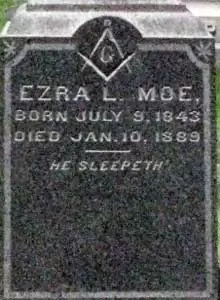
MOE, EZRA L. (1843-1889). Private, 120th New York Infantry, Company A; 19th Regiment, Veteran Reserve Corps, Company F. Moe was born in Greene County, New York. The 1860 census reports that he was living in Hurley, New York, and working as a laborer. After Moe enlisted as a private on August 6, 1862, at Hurley, New York, he mustered into the 120th New York, also known as the Washington Guards, on August 22. His muster roll notes that he was a farmer who was 5′ 6″ tall with gray eyes, dark hair and a light complexion.
The 120th New York saw action in nearly every major battle after Fredericksburg in December 1862, and was on duty when Confederate General Robert E. Lee surrendered on April 9, 1865. Just before its final engagements in March 1865, the regiment received a new flag which was inscribed with the names of the 16 battles in which it had fought. Moe’s muster roll also reports that he was absent and sick as of May 10, 1864, hadn’t been heard from in six months, and was discharged on April 28, 1865, as per General Order #77. In June 1865, the regiment was welcomed home at Rondout, New York, with a lavish reception. Rev. Henry Hopkins, the 120th Regiment’s chaplain, said, “We were crowned with flowers, every soldier had a bouquet in the muzzle of his gun.” On June 3, 1865, Moe transferred into Company F of the 19th Regiment, Veteran Reserve Corps. He was discharged from military service on November 15, 1865, at Elmira, New York.
The 1870 census notes that he was a farm laborer living in Tioga, New York. Moe is listed as a carman in the 1884 Brooklyn Directory. As per his obituary in the Brooklyn Daily Eagle, friends and relatives were invited to attend his funeral. He last lived at 197 Nassau Street in Brooklyn. He died from pneumonia. In 1890, Adelia Moe for a widow’s pension, application 468,986, but no certificate number is listed. Section 200, lot 26862.
MOESLEIN (or MOSHIER), SEBASTIAN (1832-1901). Sergeant, 1st Connecticut Heavy Artillery, Company H; musician, 41st New York Infantry; United States Volunteers Brigade Band. Originally from Bavaria, Germany, Moeslein enlisted as a musician at New York City on June 26, 1861, mustered into the Band of the 41st New York that same day, and was discharged on June 30, 1862, at Middletown, Virginia. A resident of Fairfield, Connecticut, he then re-enlisted as a private and mustered into Company H of the 1st Connecticut Heavy Artillery on November 4, 1862. He was promoted to sergeant on November 4, 1862, and was transferred to the United States Volunteers Brigade Band on March 26, 1863. In 1891, he successfully applied for an invalid pension, certificate 975,570. He last resided in New York City. Interment at Green-Wood took place on May 23, 1903. Section 206, lot 21347, grave 615.
MOFFETT (or MOFFITT), STEWART R. (1844-1892). Private, 3rd New Jersey Infantry, Company B; 12th Regiment, New York State National Guard, Company I. A New Jersey native, Moffett lived with his parents and siblings in Rahway, New Jersey, at the time of the census of 1860. After enlisting as a private on April 22, 1822, Moffett mustered into the 3rd New Jersey Infantry on April 27, and mustered out on July 31, 1861, at Trenton, New Jersey. As per his pension index, he last served in Company I of the 12th New York Regiment and had additional service in Company B of the 9th New Jersey Infantry; there are no additional details about those enlistments.
The City Directory for Newark, New Jersey, lists him as a photographer with Logan & Moffett at 299 Broad Street in 1865; his company had a gross income of $4,679 in 1867. The 1870 census indicates that Moffett was living in Newark and employed in a photograph gallery; he is also listed as a photographer in the Newark Directory for 1870 and in the 1880 census. Moffett relocated to New York City where he is listed in the 1884 New York City Directory; he lived at 174 Sixth Avenue and continued his profession as a photographer. He last lived at 432 7th Street in Brooklyn. His death was caused by an aortic aneurysm. Shortly after his death in 1892, Anna Moffett applied for and received a widow’s pension, certificate 367,638. Section 77, lot 8354.
MOGK, WILLIAM JACOB (or JACOB W.) (1836-1915). Unknown rank, 1st United States Artillery, Battery M; private, 15th New York Heavy Artillery, Company E. Originally from Germany, Mogk immigrated to the United States in 1862. He used the name Jacob Mogk on his soldier and census records. As per his pension index card, Mogk served in the 1st United States Artillery, Battery M; details of that service are unknown. He re- enlisted as a private at New York City on February 3, 1864, and mustered into the 15th New York Heavy Artillery that same day. As per his muster roll, he was a sign maker who was 5′ 5″ tall with gray eyes, light hair and a light complexion. Mogk mustered out with his company on August 22, 1865, at Washington, D.C.
In 1897, he applied for and received an invalid pension, certificate 937,852. As per the census of 1910, he was a widower who was a naturalized citizen, was able to read and write and was a survivor of the Union Army; he then lived on 20th Street in Brooklyn as a boarder. He last lived at 83 20th Street in Brooklyn. His death was attributed to bronchitis. Section 131, lot 34213.
MOHR, HENRY (1841-1881). Corporal, 54th New York Infantry, Companies B and C. Born in Hessen, Germany, Mohr enlisted on September 5, 1861, at Hudson City, New Jersey, as a private, and mustered into Company B of the 54th New York Infantry that same day. At some point, he had an intra-regimental transfer to Company C. Although his soldier record reports that he deserted at Gettysburg, Pennsylvania, on June 20, 1863, that appears to be incorrect; on December 11, 1874, he mustered into Frank Head Post #16 of the G.A.R., an organization of Civil War veterans that did not consider deserters for membership. Mohr indicated in the G.A.R. sketchbook that he was discharged as a corporal from the 54th on September 15, 1864.
Mohr was listed as a saloonkeeper in the Brooklyn Directories for 1868 and 1870, and in the G.A.R. sketchbook. An article in the Brooklyn Daily Eagle on August 2, 1872, lists Mohr as one of saloonkeepers who met and organized to resist the enforcement of the excise tax law. He was working as a saloonkeeper at the time of the 1880 census; he was living in Brooklyn with his wife and seven children. The Brooklyn Daily Eagle of January 16, 1881, noted that Mohr was elected as delegate to the State Encampment from Frank Head Post of the G.A.R. His last residence was 54 Rapelyea Street, Brooklyn, New York. His death was attributed to enlargement of the liver. As per his wife’s petition to King’s County Surrogate Court, he died without a will and had personal property worth $400. Eliza Mohr, his widow, took over his lager beer saloon at the Rapelyea Street address. The Brooklyn Daily Eagle on November 21, 1881, reported that the saloon was broken into and that three bottles of whisky and fifty cigars were stolen. Section 122, lot 17806, grave 236.
MOLLER, CHARLES A. (1834-1888). Private, 72nd New York Infantry, Company A; 73rd New York Infantry. Of German origin, Moller enlisted as a private at New York City on June 3, 1861, and mustered into Company A of the 72nd New York on June 21. On July 23, 1861, he was transferred into the 73rd New York. He died in Brooklyn but last lived at 234 Hudson Street in Hoboken, New Jersey. The cause of his death was senile gangrene (insufficient blood flow caused by degeneration of the walls of the arteries). Section 83, lot 3349.
MOLLOY, ALFRED C. (1843-1889). Landsman, United States Navy. Of Irish origin, Molloy enlisted as a landsman in the United States Navy at New York City on August 8, 1863, for a term of one year. At that time, he was an upholsterer who was 5′ 10½” tall with grey eyes, brown hair and a light complexion. It was noted that he had scars on his right arm and right cheek. Molloy served on the USS Quaker City as of August 14. He was admitted to the Naval Hospital in Philadelphia, Pennsylvania, on October 3, 1863, suffering from vulnus contusum (crush wounds). He was discharged from the hospital on November 4. He subsequently served on the USS Princess Royal as of June 16, 1864, and was discharged on October 29, 1864.
On May 26, 1873, Molloy became a naturalized citizen; at that time, he was a clerk who lived at 1 Christopher Street in New York City. His death certificate notes that he had been employed as a clerk and that he died in Kearny, New Jersey. As of July 1890, Hannah Molloy, whom he married in 1870, received a widow’s pension, certificate 5,438, of $8 per month and an additional $2 per month for each of her two minor children.
MOLLOY, JOHN COOK (1829-1873). First lieutenant, 63rd New York Infantry, Company B. Of Irish birth, he enlisted and was commissioned into the 63rd New York at Washington, D.C., on December 7, 1861, and mustered out on February 13, 1862. He last lived in Hoboken, New Jersey. Section 116, lot 11522.

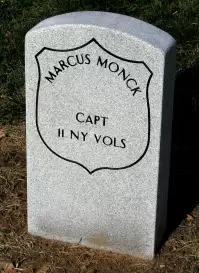
MONCK, MARCUS (1832-1862). Captain, 11th New York Volunteers. Although Monck’s naturalization papers state he was of English origin, his muster roll, family tree and death certificate indicate that his birthplace was in Banagher, Ireland. The New York City Directory for 1854 lists him as an editor for M. B. Monck & Co., publishers at 216 Pearl Street; the 1857 New York City Directory lists him as a publisher whose office was at 71 Nassau Street in Manhattan; he lived on Henry Street in Brooklyn. After filing a petition for naturalization at the Court of Common Pleas in New York City on September 17, 1855, Monck became a naturalized citizen on September 3, 1859.
During the Civil War, it appears that Monck served with the 11th Regiment-the First Fire Zouaves. His muster roll states that he was borne on the Inspection Roll in Company B of Scott’s Rifles, dated August 27, 1861, and had no service as captain in the 51st Infantry (the regiment formed by consolidation of Scott, Union and Shepard Rifles on October 11, 1861). The records of the New York State Adjutant General’s Office confirm that Monck was in Company B of Scott’s Rifles from August 27, 1861, through October 11, 1861 and New York Veteran Burial Cards state that he was a captain in the 11th Regiment, New York Volunteers.
The 1862 New York City Directory reports that Monck was an editor at 19 Beekman Street and lived in Brooklyn. An article in The New York Times on August 13, 1862, reports that Captain Munck was severely burned on August 6, 1862 in the fire at the Rainbow Hotel on the corner of William and Beekman Streets in Manhattan. He died at the New-York Hospital five days later. An inquest into his death by Coroner Wildey (see) concluded that his death was caused by accidental burns. His funeral was held at City Hospital and his remains were accompanied for burial by two companies of the Stanton Legion. The photograph of Monck (below) notes that lost his life trying to save people in a burning house in New York. Section 115, lot 13536 (Soldiers’ Lot), grave 33.
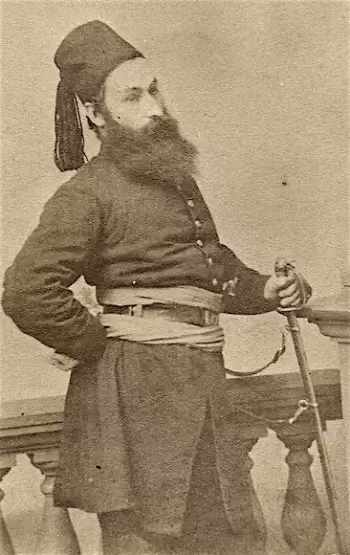
MONCRIEFF, GEORGE S. (1814-1869). Quartermaster sergeant, 5th Light Artillery, United States Army; sergeant, 3rd Infantry, United States Army, Companies I and F. A native of Scotland, he served as a sergeant in Companies I and F of the 3rd Infantry, U.S. Army. Subsequently, he re-enlisted as a quartermaster sergeant and served with the 5th Light Artillery, U.S. Army. There is no further information about his military record. His last address was in New York City and his death was caused by kidney disease. Section D, lot 7078, grave 55.
MONEYPENNY (or MONTGOMERY), WILLIAM C. (1832-1878). First lieutenant, 14th New York Cavalry, Company C; 8th Regiment, New York State National Guard, Company D. A New Yorker by birth, Moneypenny was listed as living in New York City and working as a dyer in the census of 1850. During the Civil War, he enlisted at New York City on May 29, 1862, mustered into the 8th Regiment that day, and mustered out with his company after three months on September 10 at New York City. He then re-enlisted at New York City as a first lieutenant on December 12, 1862, was immediately commissioned into the 14th New York Cavalry, and was discharged on July 13, 1863. His muster roll for the 14th Cavalry notes that he was also known as William Montgomery.
The New York City Directories for 1870 and 1875 list him as a dyer. He last lived on State Street in Albany, New York. His obituary in The Albany Daily Evening Times of October 30, 1878, reported that his remains were taken to New York for interment. Eliza Moneypenny applied for and received a widow’s pension in 1892, certificate 362,610. Section 161, lot 12578.
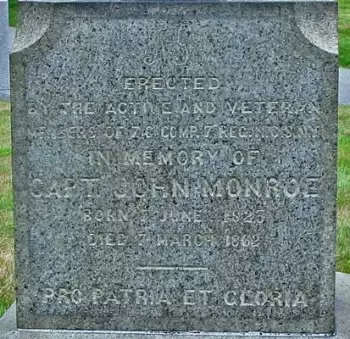
MONROE, JOHN (1823-1862). Captain, 7th Regiment, New York State Militia, Company G. As per a biography about Monroe written in 1858, he was born in Philadelphia, Pennsylvania, and came to New York City when he was two years old. His military interests started early when he became a guide boy for the Third Company National Guard when he was just nine years old. In 1843, he joined the Seventh National Guard becoming a first lieutenant on August 15, 1850, and was elected captain on March 13, 1851. When he was elected captain, his company had only eighteen men but it soon numbered nearly one hundred due to his perseverance and the respect in which his command held him. In civilian life, he was a bookkeeper.
During the Civil War, Monroe enlisted as a captain at New York City in April 1861, was commissioned into the 7th Regiment, served for 30 days and mustered out at New York City on June 3. Known as a tactician, he compiled “Manual of Arms” which was introduced at Camp Cameron in 1861. As per his obituary in the New York Tribune, his funeral was held at the New-England Church on South 9th Street in Brooklyn; members of the 7th Regiment were invited to attend in civilian dress. After his death, members of the 7th adopted resolutions of condolence and wrote, “He was an able, reliable, laborious, and intelligent officer…Of rather an unsoldierly figure, and without the personal attractions which sometime win favor, Captain Monroe achieved distinction by modest merit, and ranked high among the distinguished company commandments of the period.” An impressive monument in his honor was erected by the active and veteran members of Company A of the 7th Regiment and bears the Latin inscription, Pro Patria Et Gloria (For Country and Glory). Section 55, lot 6388.
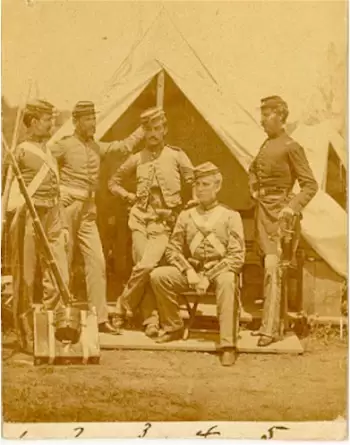
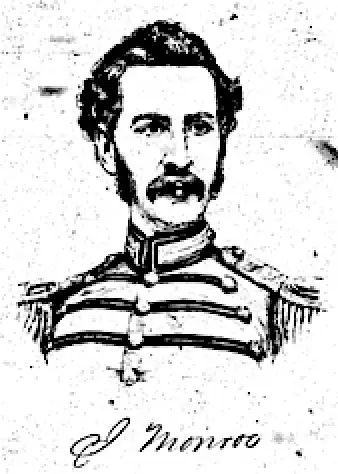
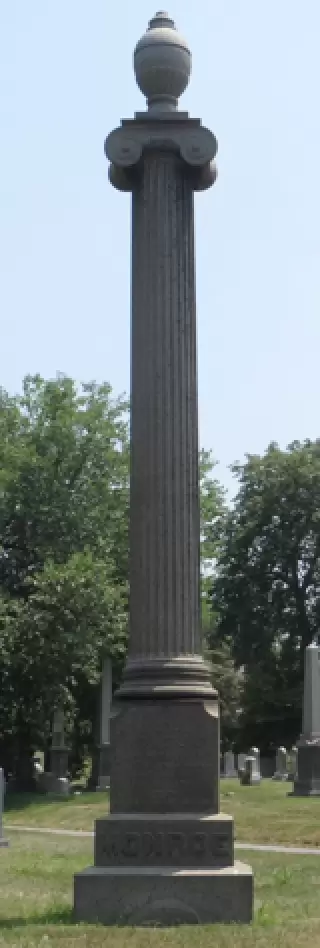
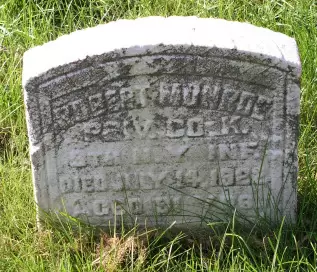
MONROE (or MUNRO), ROBERT (1831 or 1842-1922). Private, 9th New York Infantry, Company K. Monroe, or Munro, as his named is spelled on many records, was born in Scotland as per the New York State census of 1892. The year of Monroe’s birth is uncertain; although the inscription on his gravestone indicates that he died at 91 years of age, that information may not be correct. Other records indicate his birth year as 1841 or 1842. He immigrated to the United States in the 1850s; the 1910 census reports the year as 1854 whereas the 1920 census records the year as 1858.
During the Civil War, he enlisted as a private at New York City on May 3, 1861, and mustered into Company K of the 9th New York, also known as Hawkins’ Zouaves, the next day. Company K was equipped as an artillery unit. The regiment, composed of mainly New Yorkers, headed for Fortress Monroe, Virginia, on June 6, and was then quartered at Newport News, Virginia, where Monroe was discharged for disability on August 14, 1861.
He became a naturalized citizen in 1864. The 1877 and 1885 Brooklyn Directories list Robert Munro as a machinist whose home was on 41st Street and Seventh Avenue. In 1888, he applied for and received an invalid pension, using the surname of Munro, certificate 851,805. The Brooklyn Directory for 1897, using the spelling “Monroe,” lists him as a machinist at 363 41st Street. At the time of the 1905 New York State census, he was a machinist living with his daughter and son at 665 41st Street in Brooklyn. As per the census of 1910, he was still living at 665 41st Street, working as a machinist in a factory, and living with his daughter. The 1920 census indicates that he was widowed and no longer employed. According to papers filed in Kings County Surrogate Court by his daughter, the executrix of his will, on July 18, 1922, he left real estate valued at about $6,000 (about $85,000 in 2016 money) and personal property valued at about $50. His daughter, Elizabeth, was still living at the same address on 41st Street at the time of the 1940 census. Section 3, lot 21025.
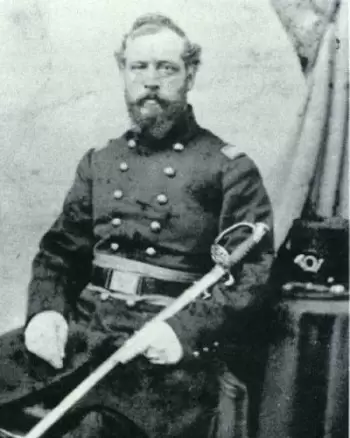
MONTEITH, WILLIAM (1827-1869). Colonel, 28th Massachusetts Infantry; second lieutenant, 12th Regiment, New York State Militia, Company C. Born in Ireland, Monteith was a hatter according to the 1850 census and a builder as per the 1855 New York State census and the 1857 New York City Directory. He entered service with the 12th Regiment on April 19, 1861, and mustered out on August 5, 1861.
He then was appointed colonel of the 28th Massachusetts on October 7, 1861. The 28th had been raised as the second Irish regiment, building on the large Irish population in Massachusetts and was known familiarly as the Faugh-A-Ballaugh (clear the way) Regiment. Among the patrons of the 28th was Patrick Donahue, the owner of The Pilot, a major Irish-American Catholic newspaper and a friend of Montieth, who despite unknown military ability, was able to secure the commission as colonel from Massachusetts Governor John A. Andrews because of his connection to Donahue. Among others who sought to raise men for the Irish regiments was the Irish nationalist, Thomas Meagher (see), who used his oratorical skills to whip the crowd into a frenzy; Meagher did not receive a commission in Massachusetts but ultimately was acting major of the 69th New York and rose to command of the Irish Brigade—which included the 28th.
As per the 28th Massachusetts Regimental History for 1862 Colonel Monteith and his men received their first two flags after training at Camp Cameron that January in an emotional ceremony led by Governor Andrew, the Boston mayor, and members of the Boston City Council. Eight days later, Monteith chose to forego the third standard state flag for a flag that featured patriotic and Irish symbols on a field of green. The Regimental History went on to say that the 28th performed well despite feuding between Colonel Monteith’s Irish New Yorkers and the locals from Boston. The 28th left for Hilton Head, South Carolina, on February 14, 1862, from Fort Columbus in New York Harbor. One of Monteith’s men, John J. MacDonald, a sergeant in Company K, wrote to The Pilot that while the Regiment lacked a chaplain, they were well cared for, had good sanitary facilities, and had become well-disciplined. In addition, MacDonald wrote about the “Monteith Literary and Aid Society,” an association of which Monteith was the patron. The objective was the well-being of the families of the soldiers. Each month, the members of the association were assessed an unstated amount for the widow and family of members who lost their lives in the discharge of their duty; it also provided for the forwarding of the remains of the deceased to their family or friends, rare benefits at the time.
Once the 28th arrived in South Carolina, it was then assigned to General T. W. Sherman’s expeditionary corps until June 1 when it was at James Island for the attack on Fort Johnson near Secessionville. However, on May 20, Montieth was dismissed for “neglect of duty” and “conduct unbecoming an officer and gentleman-drinking in his tent with privates of the 76th Pennsylvania regiment.” After he submitted his resignation on August 3, 1862, he was court-martialed at Newport News, Virginia, and was discharged from the Army on August 12.
After the Civil War, he was a hatter. As per his obituary in the New York Herald, which confirms his Civil War service as colonel of the 28th Massachusetts, he died from disease contracted in South Carolina; friends and relatives were invited to attend his funeral. He last lived at 215 West 24th Street in New York City. In 1870, Eunice Monteith applied for a widow’s pension, application 184,939, but there is no evidence that it was certified. Section 33, lot 4800.
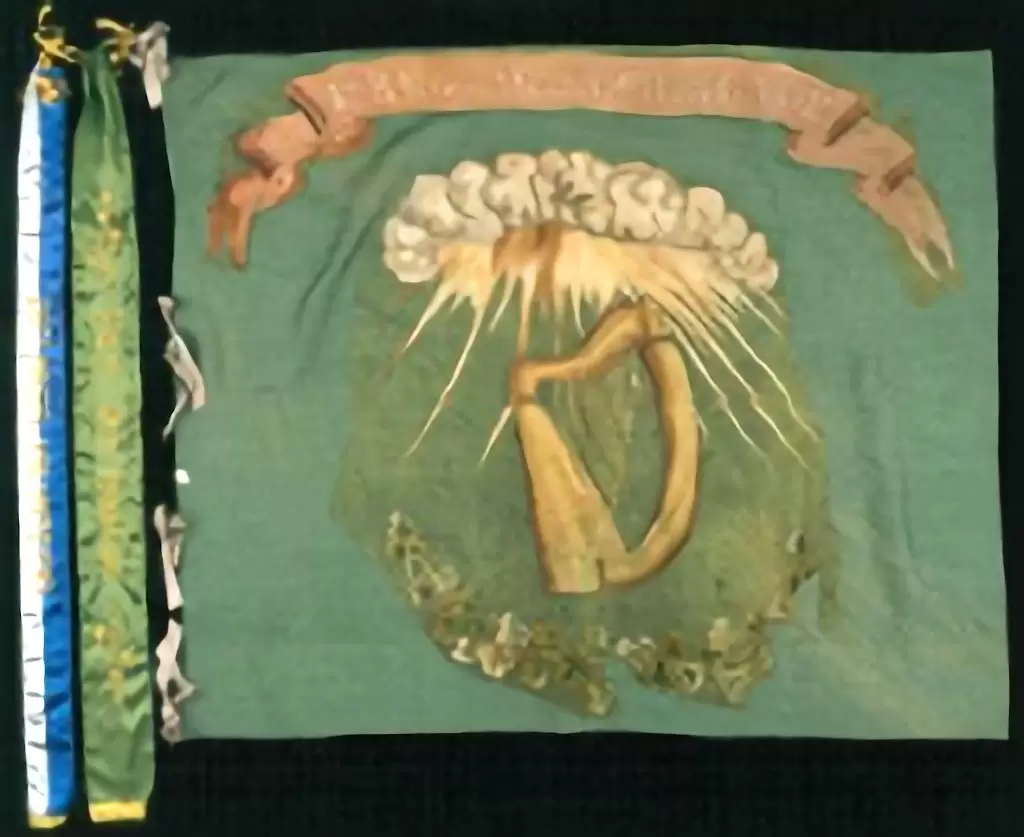
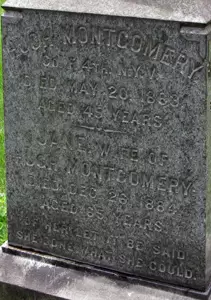
MONTGOMERY, HUGH (1818-1863). Private, 4th New York Infantry, Company F. An Irish native, the 1855 census reports that Montgomery was a grocer; Smith’s Brooklyn Directory for 1856 lists him as a grocer who lived and worked at 13 James Street. After enlisting as a private at New York City on April 22, 1861, Montgomery mustered into Company F of the 4th New York, also known as the First Scott Life Guard, on May 2. His muster roll indicates that he was absent without leave for eighty-two days from December 20, 1862 through March 12, 1863, and returned to duty under the President’s Proclamation of March 13, 1863. As per the aforementioned proclamation, soldiers who were absent without leave were allowed to return to their regiments without punishment by April 1 of that year; soldiers who returned would not be subject to arrest but would lose their pay and any allowances during the period they were away from their unit. He died of disease in New York City on May 20, 1863, just a few days before the regiment mustered out there.
As per his obituary in the New York Herald, which confirms his service in the Civil War, he was a member of the American Protestant Association, an organization comprised mainly of Irish Protestants; members were invited to attend his funeral. Newspapers in Belfast, Ireland, were forwarded information about his death. Montgomery’s funeral was at the home of his brother at 338 Greenwich Street in Manhattan. On July 2, 1863, Jane Montgomery, who is interred with him, applied for and received a widow’s pension, certificate 207,364. Section 177, lot 13872.
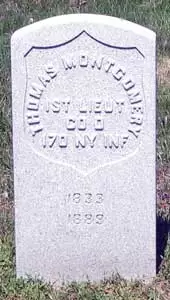
MONTGOMERY, THOMAS (1833-1889). First lieutenant, 170th New York Infantry, Company D. Born in Ireland, Montgomery first served in Company A of the 69th Regiment in 1861. His name was listed in “News of the Rebellion” in The New York Times on July 25, 1861, as among the wounded on July 23 at the Battle of Bull Run, the first major battle of the Civil War. Captain James Kelly wrote about the battle in his report to Headquarters on July 24:
Sir: I have the honor, in the absence of Col. Corcoran, missing, and Acting Lieut.-Col. Haggerty, killed in action, to report to you that on Sunday morning, July 21, at 3:30 a.m., under orders of Maj.c. Gen. McDowell, and the immediate command of Brig.-Gen. Tyler, the Sixty-ninth Regiment New York State Militia moved forward from their camp at Centreville, and proceeded by steady march to within a mile and a half of the enemy’s battery, situated on the south bank of the creek or ravine known as Bull Run. At this point we halted, Col. Corcoran commanding, Lieut.-Col. Haggerty being second in command, Capt. Thomas Francis Meager acting as major, and Capt. John Nugent as adjutant. The regiment numbered one thousand muskets, and was attended by one ambulance only, the other having broken down. The sixty-ninth had good reason to complain that whilst regiments of other divisions were permitted to have baggage and provision wagons, immediately in the rear, the regiment I have to honor to command was peremptorily denied any facilities of the sort. The consequence was that the Sixty-ninth arrived in the field of action greatly fatigued and harassed, and but their high sense of duty and military spirit would not have been adequate to the terrible duties of the day….
Kelly went on to describe the situation as the battle progressed:
…After sustaining and repelling a continuous fire of musketry and artillery, directed on us from the masked positions of the enemy, our regiment formed into line directly in front of the enemy’s battery, charged upon it twice, were finally driven off, owing principally to the panic of the regiment which we had advanced on the battery, and then endeavored to reform. The panic was too general, and the Sixty-ninth had to retreat with the great mass of the Federals.
In this action I have to record, with deep regret, the loss of Col. Corcoran (supposed to be wounded and a prisoner), Acting Lieut.-Col. Haggerty, and others, of whom a corrected list will be speedily forwarded.
Montgomery re-enlisted at New York City as a private on September 3, 1862, mustered into the 170th New York on October 7, and was promoted to first sergeant at some point. As per his muster roll, he was a carpenter (listed at “carpenter 4th”) who was 5′ 11″ tall with hazel eyes, dark hair and a florid complexion. On February 1, 1863, he was commissioned as a second lieutenant and was subsequently promoted to first lieutenant on March 15, 1864. After he was severely wounded in the left elbow at Reams Station, Virginia, on August 25, 1864, he was discharged from military service on October 18, 1864, as a result of his injury. His discharge papers, as per Special Order #327, dated October 1, 1864, noted that he would not receive any pay until “he satisfied the Pay Department that he is not indebted to the Government.” On November 3, 1864, his application for an invalid pension was approved, certificate 38,374. His last residence was on Jefferson Street in Manhattan. His death was caused by cellulitis, a skin infection. In 1905, Margaret Montgomery applied for and received a widow’s pension, certificate 604,848. Section 126, lot 2458, grave 831.
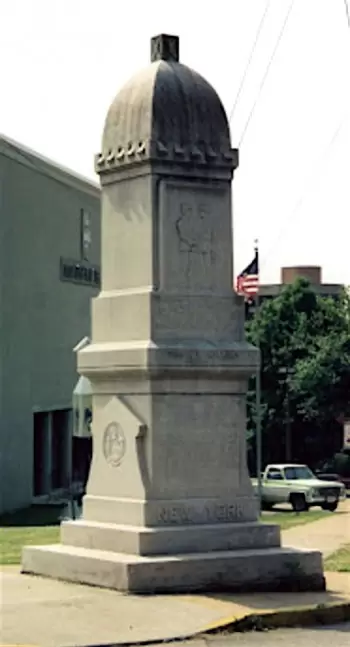
MONTGOMERY, WILLIAM S. (1830-1872). Captain, 79th New York Infantry, Companies F and D. Born in Scotland, Montgomery enlisted as a sergeant at New York City on May 27, 1861, and mustered immediately into Company F of the 79th New York, known familiarly as the Highlanders and composed mainly of men of Scottish heritage. He was promoted to first lieutenant on March 1, 1862, effective upon his transfer to Company D that day. He returned to Company F when he was promoted to captain on October 16, 1862, and served in that rank until he mustered out at New York City on May 31, 1864. Active in organizations that promoted Scottish culture and heritage, Montgomery was an active member of the Scotia Lodge of the Freemasons. His obituary in the New York Herald reported that veterans of the 79th were requested to meet at the Caledonian Club in civilian dress to attend his funeral. He last resided at 31 Sixth Avenue in Manhattan. His death was attributed to sun stroke; the World included his name as among those who succumbed to the heat on that day. The Commercial Adviser reported on August 16, 1872, that Montgomery took sick on Pier No. 20, where he worked on the Anchor line of steamers which traveled to Scotland; he succumbed in the ambulance on the way to the hospital. At the time of his death, he was a widower whose only son was in Scotland.
In September 1918, a monument was erected in Knoxville, Tennessee, commemorating the services of the 79th New York Highlanders and the prominent part that the regiment played in the defense of Fort Sanders there. The New York State Legislature, in its 1919 records, indicates that the legislature appropriated $5,000 in 1917 for the monument pursuant to a bill introduced by Alfred J. Gilchrist, a state senator whose father was in the 79th Regiment. The monument, pictured below, is made from Knoxville pink marble and contains many symbols of Scotland such as St. Andrew’s cross and the Scottish emblem of thistles and shields; the coat of arms of the State of New York is also on the monument, and, as a symbol of unity, the figures of a Confederate and Federal soldier clasp hands under an American flag are inscribed. Montgomery’s name is prominent on the plaque (below) which reads:
79TH NEW YORK INFANTRY
(HIGHLANDERS)
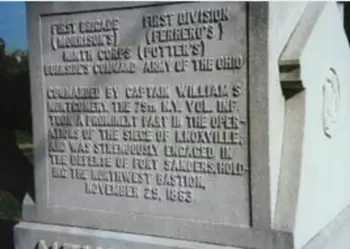
1ST BRIGADE 1ST DIVISION
(MORRISON’S) (FERRERO’S)
BURNSIDE’S COMMAND ARMY OF THE OHIO
COMMANDED BY CAPTAIN WILLIAM S. MONTGOMERY, THE 79TH NEW YORK VOLUNTEER INFANTRY TOOK A PROMINENT PART IN THE OPERATIONS OF THE SIEGE OF KNOXVILLE; AND WAS STRENUOUSLY ENGAGED IN THE DEFENSE OF FORT SANDERS, HOLDING THE NORTHWEST BASTION, NOVEMBER 29, 1863.
Section 189, lot 18701.
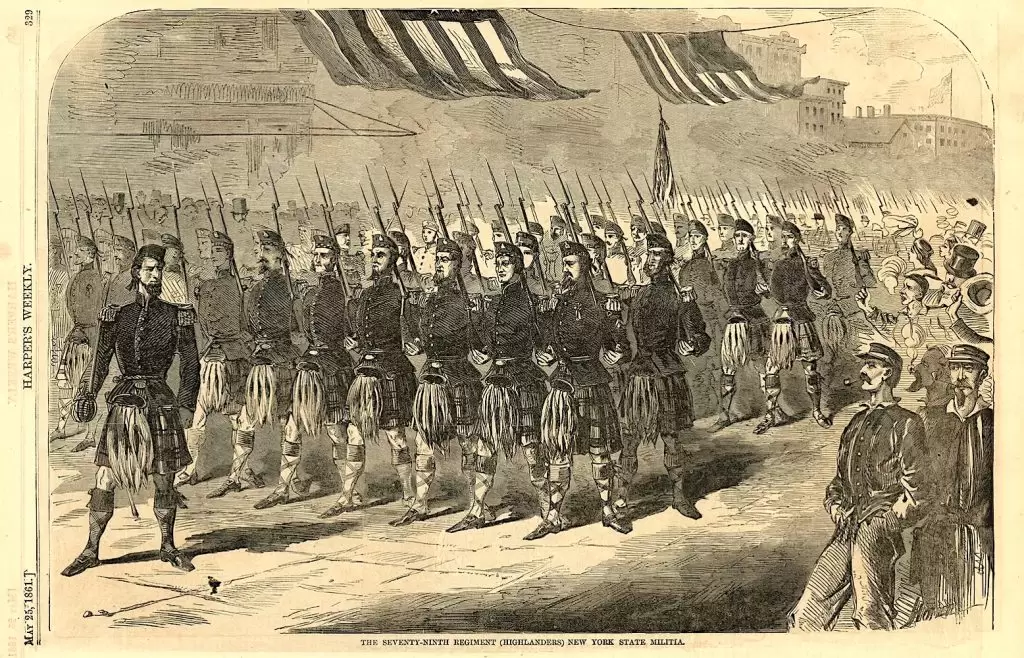

MOOD, JAMES B. OAKLEY (1842-1864). Sergeant, 13th Regiment, New York State National Guard, Company D. Mood was born in New York. In 1855, he was a student at the New-York Conference Seminary in Charlottesville, Schoharie County, New York; that same year, his family was living in New York City. Mood’s father, Peter, who is buried in the same family lot, was a renowned silversmith who learned his craft from his father in Charleston, South Carolina, and subsequently had a partnership with his brother John Mood in Charleston, then, starting in 1841, worked as a silversmith in New York City; Peter Mood was listed as a dealer of fancy goods in the 1857 New York City Directory.
At the start of the Civil War, James Mood resided on Morton Street in Manhattan. After enlisting as a sergeant to serve for three months on May 28, 1862, and mustering into Company D of the 13th Regiment (an Artillery Regiment) on that date, he mustered out on September 12 with his company at Brooklyn. He returned to service as a private when the 13th was reactivated for 30 days in 1863 and died of typhoid in Baltimore, Maryland, on November 17, 1864. As per his obituary in The New York Times, his funeral was held at his parents’ home at 81 Morton Street in Baltimore. Section 12, lot 7656.
MOODY, MATTHEW HENRY (1845-1911). Captain, 23rd Regiment, New York State National Guard, Company C. Moody was born in New York and educated in Brooklyn. As per his obituary in the New York Tribune, Moody was a captain of Company C in the 23rd Regiment during the Civil War. No further details of his service are known. The Internal Revenue Service (IRS) records for 1866 report that he had earned $600 that year; the 1867 Brooklyn Directory indicates that he was working as a clerk. As per the 1870 census, Moody lived in Brooklyn with his mother, siblings, and others; he was single, and worked as a leather dealer. The 1880 census indicates that he was married with one child, lived in Brooklyn, and was in the leather manufacturing business. The 1906 New York City Directory reports that he lived at 91 Gold Street. He died in a runaway accident in Parkdale, Oregon, on June 19, 1911. His obituary notes that before relocating to Oregon, Moody had been a longtime Brooklyn resident. Section 70, lot 363.
MOORE, ALFRED (1837-1910). Private, 84th New York (14th Brooklyn) Infantry, Company H. Born in London, England, he immigrated to the United States in 1858. The 1860 census reports that he lived with the family of William Payne; Moore was not a relative of Payne’s but was his apprentice upholsterer. During the Civil War, he enlisted at Brooklyn on April 18, 1861, and mustered into the 14th Brooklyn on May 23. Moore’s muster roll indicates that he was an upholsterer. During his service, he was captured in action and taken as a prisoner of war on August 28, 1862, at Groveton, Virginia, and exchanged on October 15, 1862. One biography indicates that he appeared before a court-martial on February 1, 1864, for being absent (AWOL) for six weeks but he received no punishment. He mustered out on June 6, 1864, at New York City. As per his obituary in the Brooklyn Daily Eagle, which confirms his Civil War service, Moore re-enlisted in the 14th Regiment, New York State National Guard, and served until 1888.
The censuses of 1870 and 1880 list Moore’s occupation as upholsterer; he had an upholstery business in a two-story building in Brooklyn that employed seven people. After leaving the National Guard in 1888, he became a member of the War Veterans Association of the Fourteenth Regiment. An article in the Brooklyn Daily Eagle on January 19, 1896, about the funeral of Brigadier General Edward Brush Fowler (see), reports that Moore was part of the honor guard when Fowler lay in state at Brooklyn’s City Hall. The census of 1900 notes that Moore was a naturalized citizen. In 1908, his application for an invalid pension was granted, certificate 1,150,862. His last residence was at 211 Schenectady Avenue in Brooklyn. His death was caused by gastroenteritis. He bequeathed $4,000 to one of his daughters; the rest of his estate, consisting of real and personal property, was left to his two sons and two other daughters. Section 4, lot 32956, grave 2.
MOORE, AUGUSTUS G. (1843-1865). Private, 145th New York Infantry, Company D. Born in New York, Moore enlisted at New York City as a private on August 19, 1862, and mustered immediately into the 145th. Other details of his service are not known. His last residence was on 62nd Street and Second Avenue in Manhattan where he died from chronic diarrhea. Section 80, lot 10822.
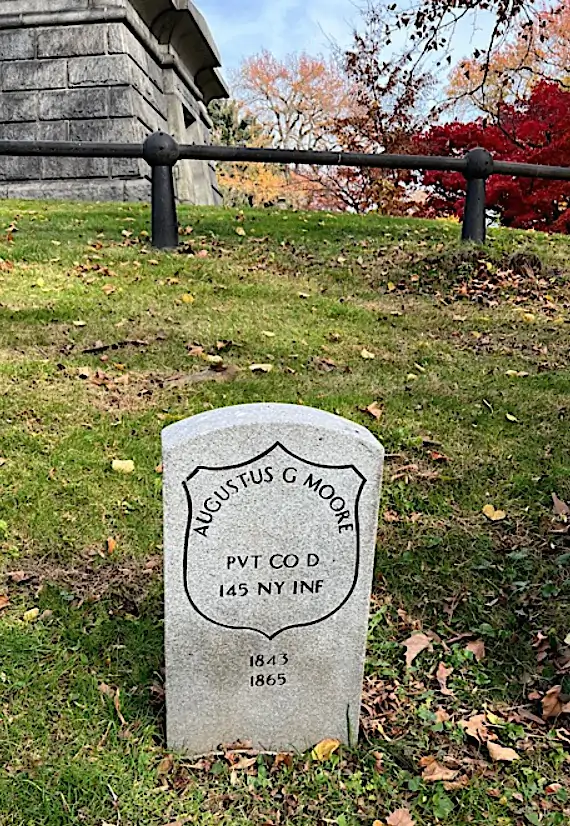
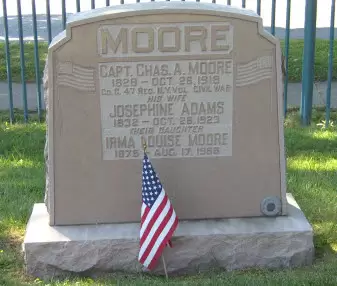
MOORE, CHARLES A. (1828-1918). Captain, 47th New York Infantry, Company G. Born in New York City, Moore was working as a clerk at the time of the 1850 census. During the Civil War, he enlisted as a captain on August 15, 1861, at East New York, and mustered into the 47th New York. The Veterans Census of 1890 indicates that he was wounded at James Island, South Carolina, in October 1861. He was discharged on September 10, 1864. His obituary in the Brooklyn Daily Eagle, which confirms his Civil War service, notes that he was acting colonel of the 47th for four months, commanding the regiment before the Battle of Petersburg, Virginia. The obituary also notes that he earned numerous Congressional medals for distinguished service in many battles and that he always wore them.
The 1870 and 1880 censuses report that Moore was a clerk in a bonded warehouse. Moore was also active in the Volunteer Fire Department for fourteen years. His last residence was 95 Ross Street in Brooklyn. His obituary reports that he died shortly before his 60th wedding anniversary. In 1918, Josephine Moore, who is interred with him, applied for and received a widow’s pension, certificate 870,514.Section 199, lot 36015, grave 1560.
MOORE, EDWIN M. (1839-1926). Private, 71st Regiment, New York State National Guard, Company G. A New Yorker by birth, Moore enlisted there as a private on May 28, 1862, mustered into the 71st that day, and mustered out after three months on September 2 at New York City. The census of 1900 reports that he was a bookkeeper for a physician; the census of 1910 reports that he was a bill collector. He was not working at the time of the 1920 census. Moore’s obituary in the Brooklyn Daily Eagle notes that he last lived at 45 Hopkinson Avenue in Brooklyn; as per census records, he had lived there for thirty years. He died from pneumonia. Section 201, lot 24916, grave 3.
MOORE, JOHN P. (1799-1881). Gun supplier to Union Army. Moore, a native of New York City, was educated in the public schools before he dropped out and became an apprentice to Benjamin Cooper, a gun smith. His sporting goods store was one of the first established in New York City in 1822 or 1823 at 206 Broadway; the business later moved next door to 204 Broadway. A balance sheet, published by the New York State Legislature in 1838, notes a purchase of flints for $1.00 from Moore & Baker. Moore was also allied with Samuel Colt, the inventor of pistols which bore his name. In Transactions of the American Institute of the City of New York (1852) it is reported that Moore was a judge in a firearms competition that awarded Colt a gold medal and diploma for “the best revolving pistols of superior workmanship.” In 1855, Colt (who manufactured his revolvers in Hartford, Connecticut) presented Moore with a custom Pocket Percussion Revolver, now part of the Metropolitan Museum of Art’s collection, the handle of which was carved from the Charter Oak, an ancient tree revered as a symbol of Connecticut’s struggle for liberty. After his sons, George and Henry T., joined the firm in 1855, the business became known as John P. Moore & Sons. As of January 31, 1860, when he retired, the firm’s name was changed to John P. Moore’s Sons.
During the Civil War, John P. Moore’s Sons, was a major supplier of rifles for the Union Army. As per the IRS Tax Assessments for 1862, the business was valued at $10,859, a substantial sum for that time, and owed taxes of $325.77. In 1863, the business relocated to 208 Broadway. After the Civil War, the store began to offer an extensive line of fishing tackle. The 1878 New York City Directory lists John P. Moore’s Sons as a gun business at 808 Broadway in Manhattan. As per his obituary in The New York Times, he was very active after he retired from his business. For many years, Moore was the president of the General Society of Mechanics and Tradesmen, and took pride in the success of its Apprentices’ Library. He was also Director of the Jefferson Fire Insurance Company, a position he held for 25 years, and a director of the Mechanics’ Bank. That obituary notes that he well-known for his integrity and honesty in business. In 1885, the business was at 302 Broadway and specialized in guns and rifles, pistols, sporting goods, fishing tackle, ammunition and other gunsmen’s supplies. Ads from the business in the 1880s are below. He last lived at 124 Madison Avenue in Manhattan. Section 161, lot 13280.
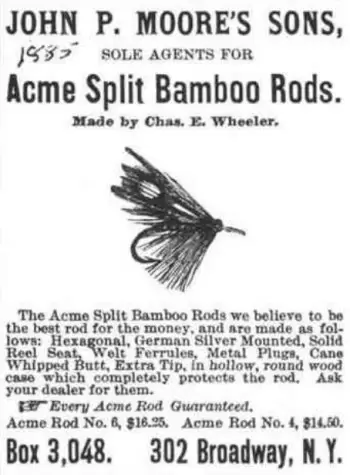
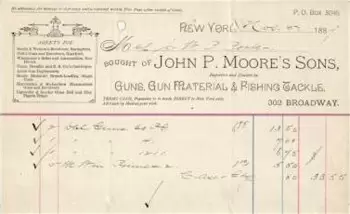
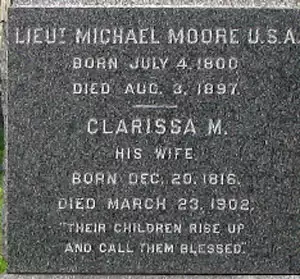
MOORE, MICHAEL (1800-1897). Second lieutenant, United States Army. A native of New York City, Moore grew up in the Canal Street area of Manhattan. His obituary in the Brooklyn Daily Eagle notes that his father fought in the American Revolution and took part in the surprise attack on the Hessians at Trenton, New Jersey. Michael Moore had a long career of military service dating back to 1812, including an enlistment as a sergeant on May 4, 1841, in the United States Army General Services, and continuing through December 15, 1870. His obituary in The New York Times, August 4, 1897, cited, “Moore’s first appointment was as a drummer boy in the Company of Captain John Sproull. With an older brother he made his way to Albany just at the breaking out of the War of 1812 and enlisted. His regiment participated in the assault and capture of Fort George, Canada, May 27, 1813. He fought the battle of Stony Creek, and later in the campaign at Sackett’s Harbor and on the St. Lawrence River.
The Brooklyn Daily Eagle reports that he immediately re-enlisted in the Army after the end of the War of 1812 and became a member of the 2nd Regiment of Infantry. In 1821, he was detailed to Sault Ste. Marie and in 1826, was a member of Governor Lewis Cass’s expedition to negotiate a peace treaty with the Indians. (Cass was governor of the Michigan Territory.) Moore served against the Indians in the West and South and fought in the Black Hawk and Seminole Wars. In 1841 he was stationed at the recruiting office at Bedloe’s Island, and remained on active duty there until 1869, when he received his commission as 2nd Lieutenant.”
The Brooklyn Daily Eagle reports that although on the retired list as of 1872, he continued his interest in military affairs. He was a charter member of the Military Society of the War of 1812 and an honorary member of the Military Order of Foreign Wars. He had been married for sixty-three years. Moore last resided at 20 Seventh Avenue in Brooklyn. His obituary notes that he died from “extreme old age,” but he had been incapacitated after breaking his hip a few years before his death. As per an article in the Brooklyn Daily Eagle on August 5, 1897, Moore’s funeral, at his late residence, was very simple and limited to family and a few intimate friends. The article reports that in accordance with his widow’s wishes, there were no military displays or tributes at his services. He was laid to rest in a plain black casket; a medal of the Society of the War of 1812 and the button of the Military Order of Foreign Wars were placed on his heart. In 1899, Clarissa C. Moore, applied for a widow’s pension, application 662,622, but there is no certificate number. Section 138, lot 27103, graves 7 and 8.
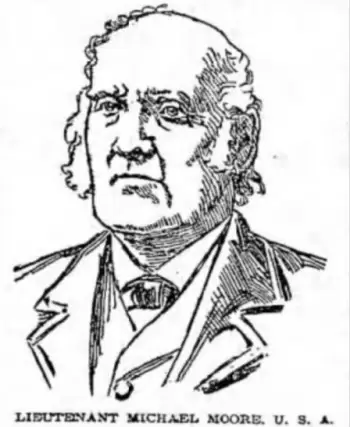
MOORE, WALLACE L. (1839-1862). Private, 12th New York Infantry, Company E. A New Yorker by birth, the 1860 census reports that he was a clerk. During the Civil War, Moore enlisted as a private at New York City on January 2, 1862, and mustered into the 12th New York on January 16. He died of typhoid fever on April 23 of that year at Chesapeake General Hospital near Fortress Monroe, Virginia, and was interred at Green-Wood four days later. His death was announced in the New York Tribune on April 26 and in The New York Times in its quarterly report of deaths in the Old Point area on July 27, 1862. In 1891, Harriet Moore, his mother, applied for and received a pension, certificate 339,590. Section 16, lot 11096.
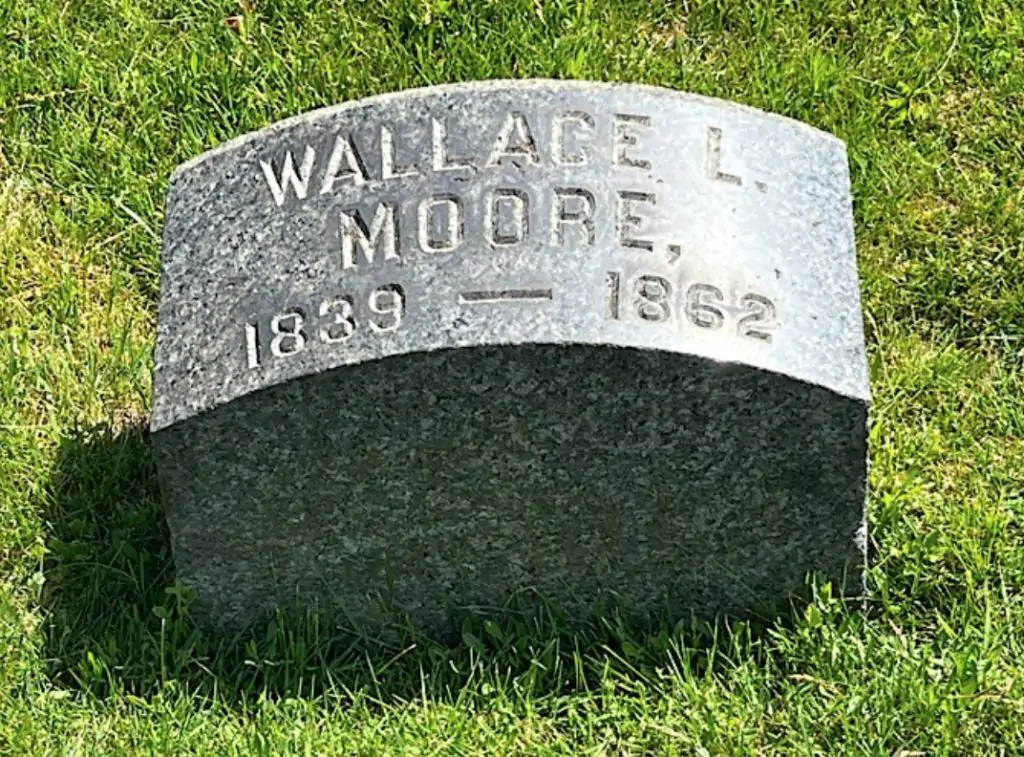
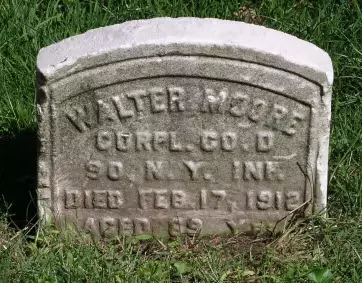
MOORE, WALTER (1842-1912). Corporal, 90th New York Infantry, Companies G and D. A native of England, his family immigrated to the United States in 1852. As per his obituary in The New York Times, which confirms his Civil War service, he first served in the 14th Brooklyn Regiment. He enlisted as a private and mustered into Company G of the 90th New York on August 23, 1862, at New York City. Transferred to Company D on November 28, 1864, he was promoted to corporal on March 4, 1865, and mustered out on June 3, 1865, at Washington, D.C.
Moore was a member of the Stephen H. Thatford (see) Post #3 of the G.A.R. The 1870 and 1880 censuses and the 1878 Brooklyn Directory report that was employed as a stair-builder. In 1871, Moore’s application for an invalid pension was granted, certificate 721,843. The Veterans Schedule of 1890 confirms his Civil War service. As per the census of 1900, he was a carpenter; he was not working at the time of the 1910 census. His obituary in the Brooklyn Daily Eagle reports that he belonged to several fraternal organizations and had lived in Brooklyn for more than sixty years. That obituary indicates that Moore died after a protracted illness that was linked to the hardships he had endured during his Civil War service. His last residence was 476 16th Street in Brooklyn. Shortly after his death in 1912, Hannah Moore, who is interred with him, applied for and received a widow’s pension, certificate 744,850. Section 132, lot 33587.
MOORE, WILLIAM H. (1826-1883). Private, 87th New York Infantry, Company B; 173rd New York Infantry, Company B. A New Yorker by birth, he enlisted at Brooklyn on August 28, 1862, mustered immediately into the 87th, and was transferred into the 173rd New York on September 11. Further details are unknown. His death was attributed to paralysis. Section H, lot 17648.
MOORE, WILLIAM J. (?-?). Unknown soldier history. A Civil War veteran’s gravestone was ordered for him in 1895 to be placed at Green-Wood. His soldier history and his interment location at Green-Wood are unknown. Section ?, lot ?.
MOORES, JR., FREDERICK WASHINGTON (or FRANCIS, F. W.) (1842-1882). Acting third assistant engineer, United States Navy. Moores, the son of a Navy master, was born in Wethersfield, Connecticut, in 1842, although cemetery records incorrectly list his birth year as 1852 and his given name as Francis, similar to his mother’s name (Frances Stillman Moores). He was educated in Boston, Massachusetts, and attended Norwich University from 1861 through 1863, where he was a member of the Pi Kappa Alpha Freshman Fraternity.
During the Civil War, Moores enlisted as an acting third assistant engineer and was commissioned into the United States Navy on July 14, 1863. He served in the North Atlantic Squadron aboard the USS Ohio, USS Howquah and the USS Ticonderoga. A medical report from the USS Ticonderoga on November 28, 1866, indicates that he had symptoms consistent with late-stage syphilis but attributed his illness to epilepsy. That medical report indicated that Moores suffered from violent epileptic seizures on April 2, August 15, and November 11, 1866; his epileptic attacks were attributed to “excesses on shore.” In addition, he had inguinal and scrotal hernias on the left side and undescended testicle on the right side Moores was honorably discharged on March 26, 1867.
According to an advertisement in the Brooklyn Daily Eagle on January 12, 1869, Bailey J. Hathaway joined Moores at The Real Estate and Insurance Agency at 413 Gates Avenue in Brooklyn. Although the Brooklyn Directory reported Moores as an engineer in its 1869 listing, the 1873 Brooklyn Directory notes that he was in real estate at 425 Gates Avenue. He was a resident in the New Jersey State Asylum for the Insane in 1880. His funeral was held at his mother’s residence at 919 Broad Street in Newark, New Jersey. Section 83, lot 9713.
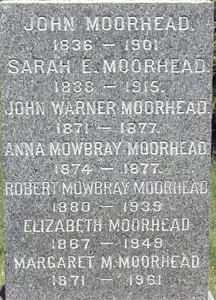
MOORHEAD, JOHN (1836-1901). Captain, 71st Regiment, New York State National Guard, Company F. Born in Philadelphia, Pennsylvania, he enlisted at New York City as a first lieutenant on May 28, 1862, was commissioned into the 71st New York State National Guard the same day, and mustered out with his company after three months on September 2 at New York City. On June 30, 1863, he was promoted to captain and commissioned into the same company, served for 30 days and mustered out on July 22, 1863, at New York City.
The Veterans Schedule of 1890 confirms Moorhead’s Civil War service. The 1891 and 1895 Brooklyn Directories list him as a clerk; the 1900 census reports his occupation as sexton. According to his obituary in the New York Herald, he belonged to the 71st Veterans’ Association; members of the organization were invited to his funeral. His last address was 318 Madison Street in Brooklyn. In 1901, He died from pneumonia. Sarah Moorhead, who is interred with him, applied for and received a widow’s pension under certificate 528,406. Section 163, lot 14663, grave 2.
MORE, JOHN (1822-1895). Lieutenant colonel, 79th New York Infantry, Company D. A native of Stirlingshire, Scotland, More married in 1845, and immigrated to New York in 1850. During the Civil War, he enlisted as a first lieutenant at New York City on May 27, 1861, was immediately commissioned into Company D of the 79th New York. The 79th saw its first major battle action at First Bull Run on July 21, 1861. It suffered substantial casualties there: 26 killed, 18 wounded, and 52 taken prisoner. More’s great-great grandson has posted an anecdote about his ancestor lying on the battlefield at Manassas after First Bull Run. As the story was told to the family, More was severely wounded by shrapnel to his legs and was giving the Masonic signal of distress in hopes that a fellow Mason would recognize a comrade. A Confederate who was checking the field for the wounded recognized the signal and summoned an ambulance which took More to a field hospital. More had a concealed revolver and ordered the surgeon not to remove his leg; the surgeon complied and sent More to a hospital where he recovered and was ultimately released to Union lines.
More rose to the rank of captain on October 28, 1861. He commanded the 79th at the engagement at Port Royal Ferry, South Carolina, on January 1, 1862, and during General Pope’s operation in Northern Virginia from August 16 to September 2, 1862. During this period, More was wounded and captured at the Battle of 2nd Bull Run (Manassas, Virginia) on August 30, 1862, and paroled on September 15. On November 26, 1862, he was promoted to major and transferred to the Field and Staff, and subsequently rose to the rank of lieutenant colonel on February 17, 1863. Another anecdote about More posted by his great-great grandson reports that during the Spotsylvania Campaign in the spring of 1864, More had a group of Highlanders from Company D “capture” a local civilian to guide them to the Confederate pickets at Spotsylvania; the civilian did so and was freed. More had given orders to shoot the man if the civilian had directed his men in the wrong direction. In addition, the descendant posted that More’s 12-year-old son, Maxwell More, was with the Highlanders during the South Carolina Campaign. On May 31, 1864, Lieutenant Colonel More mustered out at New York City.
On February 1, 1866, More applied for and received an invalid pension, certificate 59,992. The 1870 census and New York City Directory for 1892 note that he was a builder. More built many brownstones and installed the first electric elevator in the Hotel Astoria which later became the Waldorf Astoria. In 1893, More presented his daughter, Jenny Southard, the medal pictured below at a dinner hosted by the New York Caledonian Club which honored More; the Confederate who saved his life at Bull Run was also in attendance. More’s obituary in the New York Herald, which confirms his Civil War service, indicates that he was a Freemason and a member of the New York Caledonian Club and the 79th Highlanders Veteran Association; members of those organizations were invited to attend his funeral. He last lived at 41 West 98th Street in Manhattan. His death was attributed to apoplexy. Section 27, lot 10907, grave 6.
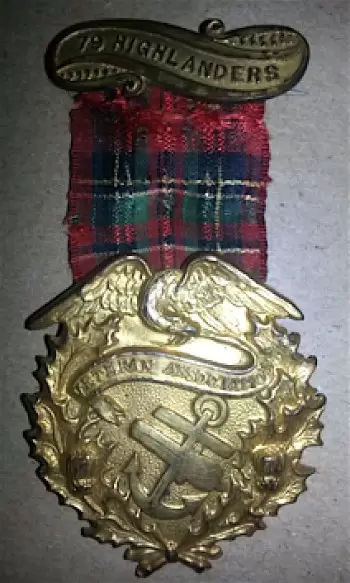
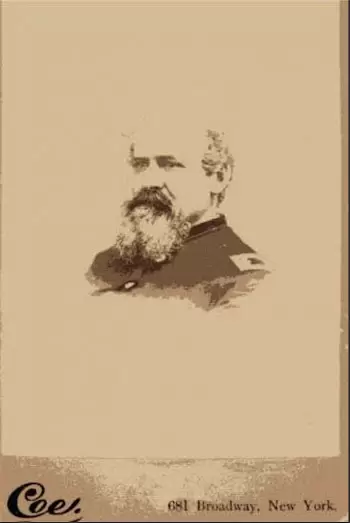

MORE, JOHN OSBORNE (1845-1862). Private, 83rd Pennsylvania Infantry, Company K. Originally from Erie County, Pennsylvania, he was living there with his parents and siblings, as per the 1850 census; his father was a farmer. During the Civil War, he enlisted at Erie County as a private on September 10, 1861, and mustered into the 83rd Pennsylvania that same day. As per the Find A Grave website, he was injured in battle and then placed on a hospital ship; no mention of wounds is on his soldier record. More died at sea of camp fever circa May 10, 1862, aboard the hospital steamer Ocean Queen, although his soldier record indicates that he died at New York City.
As per an article in The New York Times on May 10, 1862, when the ship was docked at the North River, the steamer was filled with more than 800 sick soldiers who were placed on the ship after the Confederate evacuation of Yorktown, Virginia. Frederick Law Olmstead, the Sanitary Commission’s treasurer and the organizing force behind the hospital transport fleet, wrote in a letter about the conditions on the vessel, “The surgeons immediately distributed themselves over the ship, prescribing for the worst cases-there were several men dying or near it-one dead-but it was daylight the next morning before our medicines could made be fully available. The men had swarmed into every part of the ship, and she necessarily a pig stie (sic) in filth and stench. Nobody knew who or exactly how many were on board.” As per Pamela D. Toler in Heroines of Mercy Street (2016), nurses were desperately needed on the Ocean Queen, where many of the men suffered from typhoid fever, but Olmstead pulled several from the ship because they could not be spared in Yorktown. More was interred at Green-Wood on May 13, 1862. In 1879, a government-issued headstone was ordered for him. Section 30, lot 6483.
MOREHEAD, GEORGE ROBERT (1843-1915). Sergeant, 12th Regiment, New York State Militia, Company F; private, 11th New York Infantry, Company H. Originally from Litchfield, Connecticut, Morehead enlisted as a private and served for three months in the 12th Regiment during 1861. On April 13, 1862, he re-enlisted as a private and mustered into Company H of the 11th New York Infantry; he mustered out with his company on June 2, 1862. Morehead then re-enlisted as a sergeant on May 31, 1862, and returned to the same regiment and company of the 12th Regiment, then a part of the New York State National Guard. He was discharged after three months on October 8.
After Morehead’s marriage to Lydia Mesler in 1872, they had eight children in thirteen years. The 1879 New York City Directory and the 1880 census list him as an express agent (one responsible for the packing and/or handling and delivery of cargo); at the time of the 1880 census, he lived in Brooklyn. Morehead mustered into the George B. McClellan Post #552 of the G.A.R. on October 2, 1889; an article in the New York Press on January 21, 1900, reports that he had been elected sergeant major of that post. As per the 1900 census, he was still working as an express agent. On March 20, 1891, he applied for membership in the Sons of the American Revolution, citing that he was the great-grandson of Benjamin Bissell of Litchfield. In 1892, his application for an invalid pension was approved, certificate 834,466. He last lived at 43 Barrow Street in Manhattan. Shortly after his death from pulmonary tuberculosis in 1915, Lydia Morehead, who is interred with him, applied for and received a widow’s pension, certificate 802,275. Section 136, lot 28070, grave 402.
MOREHEAD, STEWART (or STUART) G. (1840-1863). First sergeant, 43rd New York Infantry, Company I. Morehead was born in Ireland, although some documents incorrectly say New York. As per the 1855 New York State census, he was a clerk and a boarder in New York City. The 1860 census indicates that he was a boarder with Mary Gilfillan and her children, including William Gilfillan (see) at 134 East Broadway in Manhattan. That census incorrectly states that he was born in New York and reports that he was in the dry goods business. On October 20, 1860, Morehead became a naturalized citizen.
During the Civil War, he enlisted as a sergeant on August 29, 1862, at Albany, New York, and mustered into the 43rd New York on September 14. As per his muster roll, he was a clerk who was 5′ 8″ tall with blue eyes, dark hair and a light complexion. He was promoted to first sergeant on July 1, 1863. On September 8, 1863, he was killed in battle at Rappahannock Station, Virginia. Morehead is buried in the same lot as William H. Gilfillan who served as a captain in the 43rd New York; Gilfillan died at the Battle of Gettysburg. Section 162, lot 14181.
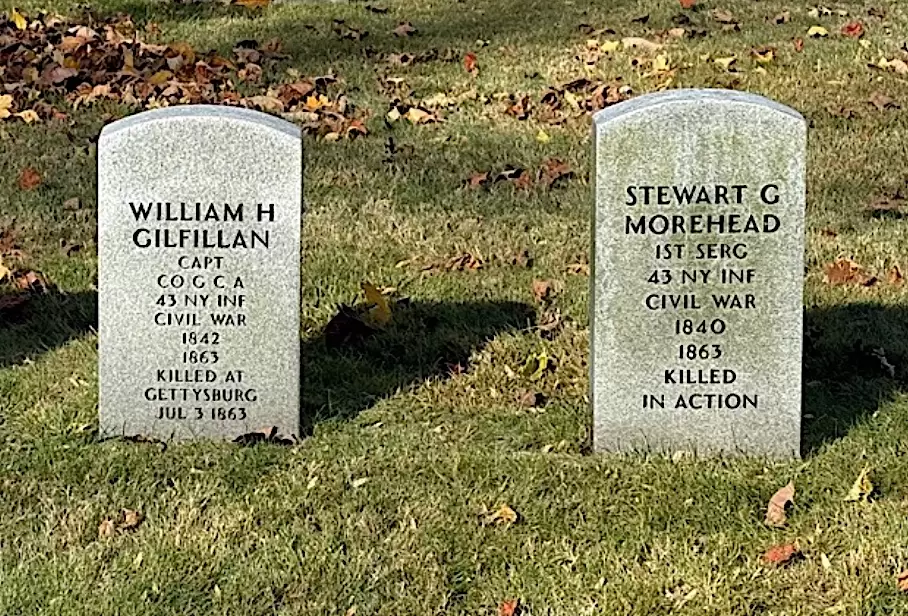
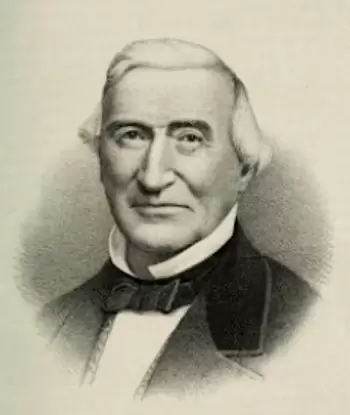
MORGAN, CHARLES (1795-1878). Shipping and railroad magnate. As per his obituary in The New York Times, he was a direct descendant of James Morgan, a native of Wales, who left Bristol, England, in 1636, to settle in America, eventually residing in what is now New London, Connecticut. Charles Morgan was born on a farm in Clinton, Connecticut, was educated in New England schools, went to New York City at the age of fourteen and, with little formal education, began work as a grocery clerk.
At the age of twenty-one, Morgan opened a shop on Peck Slip in New York City to supply provisions for ships. This business prospered, and he became involved in trade with southern ports, bringing fruit to New York. He owned a line of vessels which sailed to the West Indies, built ships, and ran steamers to Charleston, South Carolina, and Texas. As per his obituary, Morgan realized the potential of developing shipping to Texas in 1835, when Texas and Mexico were engaged in the struggle for Texan independence. After sending the first steamer, the Columbia, from New Orleans to Galveston, the latter city, which had little commerce, soon grew exponentially. His steamer service radiated out from Galveston to nearby ports. Morgan wasn’t discouraged by initial shipwrecks and soon had a better fleet, the Morgan Texas Line, of merchant ships and a ferry service on Lake Ponchartrain in Louisiana. He was also active in trade with California during the Gold Rush. He offered passenger service from New York to San Francisco through Panama. His business in the West resulted in rivalry with Cornelius Vanderbilt, eventually ending in a truce in 1858.
Just before the Civil War he had a virtual monopoly on shipping along the Gulf of Mexico. He also owned the Morgan Iron Works, established in 1836, which specialized in steam engines, boilers, and machinery for heavy marine engines. His son-in-law G.W. Quintard ran the iron works and built more machinery there for the Union Navy than was built anywhere else. Morgan sold his interest in the Morgan Iron Works during Reconstruction.
During the Civil War, most of his ships were chartered by the Union; three were seized by the Confederates. One of the seized ships, the Charles Morgan, named for him, was a schooner launched in 1854. That vessel was seized at New Orleans in mid-January of 1862 and renamed for the Governor Moore for Louisiana’s Governor Thomas Overton Moore. That ship, converted to a gunboat, was reinforced with strips of railroad iron to protect her boilers. On April 24, 1862, the Governor Moore was engaged in battle with Union Admiral David Farragut’s fleet, which was en route to capture New Orleans. After the Governor Moore rammed the USS Varuna, forcing her aground, the Governor Moore attacked the USS Cayuga, and exposed herself to Union fire. She was soon subject to relentless fire, her upper hamper shot away and 64 men of her crew dead or dying. The disabled vessel drifted ashore where her captain, pilot and a seaman set the ship afire. When the Governor Moore blew up, those three and three other survivors were captured by the USS Oneida and were imprisoned onboard the USS Colorado; about two dozen men escaped; one third of them were soon captured. The Governor Moore sank, its slain men set afire, with the Louisiana colors still flying.
After the war, Morgan continued his dominance of shipping and railroading in the Gulf ports area. During Reconstruction, he took advantage of low prices and repurchased many steamships that had fallen into Confederate hands. In addition to expanding his fleet, he resumed his Gulf packet service between New Orleans and Texas and between New Orleans and Mobile, Alabama, and purchased his first railroad in 1869. By 1870, he was the largest ship owner in the United States. Morgan City, Louisiana, at the terminus of one of his railroads, was re-named in his honor in 1876, having been previously known as Brashear City. The honor was bestowed on Charles Morgan because he was the first to dredge the Atchafalaya Bay Ship Channel to accommodate ocean-going vessels. His obituary in the Brooklyn Daily Eagle reported that his rail lines ran from New Orleans to Morgan City, Louisiana, and from Indianola to Victoria, Texas.
His obituaries note that he lived a long and healthy life, working until a month before his death. During his lifetime, he still maintained a connection with his hometown of Clinton, New York, erecting a schoolhouse there and presenting it with an endowment of $200,000. He last lived at 7 West 26th Street where he succumbed to Bright’s disease. He was survived by his second wife and two married daughters; he had two sons who predeceased him but left families.
On May 12, 1878, The New York Times published an article about the funeral of this “millionaire” at the Rutgers Presbyterian Church at Madison Avenue and 29th Street. The church was filled with family and members of the shipping community, merchants, bankers and public officials. The Reverend Nathaniel W. Conkling referred to Morgan as a man who was “an example of industry, never failing integrity, and uniform Christian-like conduct. It was said that he “left behind him more monuments of good than many rulers of the earth…” His body was in a velvet casket with silver embellishments including a plate bearing his name and life dates. About 30 private carriages attended his interment at Green-Wood. Another article in The New York Times that same day noted that businessmen in Wilmington, Delaware, gathered at Clayton House there to pay their respects to Morgan.
The New York Times cited the New Orleans Picayune on May 13, 1878, which said of Morgan, “Louisiana has lost in this gentleman a true and powerful friend, and few capitalists have accomplished more for her material interests than he though he labored in quiet and without ostentation. Mr. Morgan was modest, industrious, abstemious, and temperate in his habits, upright in his dealings, and passed a life which should supply useful lessons to all who contemplate it.” His obituary in the Brooklyn Daily Eagle, notes that he left a fortune of $13,000,000, which was to be divided by his family. That obituary indicates that Morgan built 107 sailing and steam vessels during his 70 years in business. On June 4, 1878, the Brooklyn Daily Eagle reported that his will was admitted to probate and that his thirteen million would be distributed to the next of kin as per State law; there was no litigation over his will. Morgan’s railroads were purchased by the Southern Pacific Railroad in 1883 for $7,500,000, and became part of that system. Today, Morgan City famously hosts the annual Louisiana Shrimp and Petroleum Festival. Section 81, lot 2590.
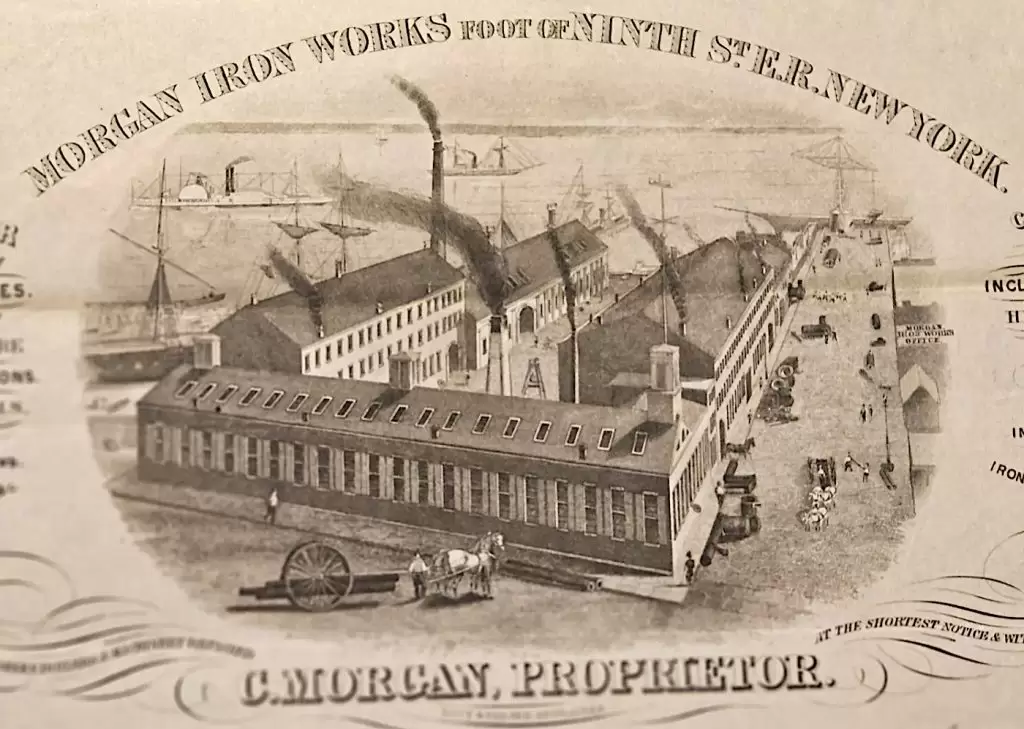
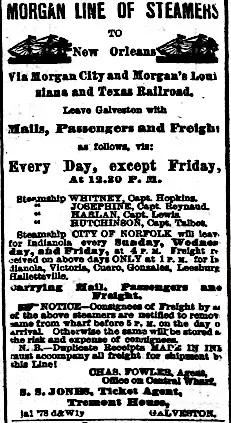
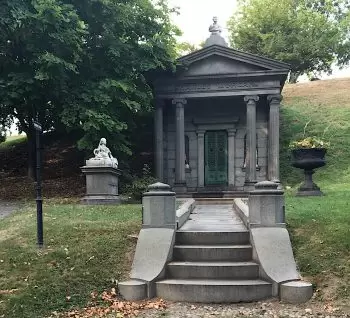
MORGAN, RICHARD CECIL (1839-1884). Lieutenant colonel, War Department. Born in Reading, Pennsylvania, he was one of the first to introduce the American sewing machine to London, England, in 1856. As per his passport application of January 8, 1861, Morgan was 5′ 8½” tall with grayish-blue eyes, light brown hair, fair complexion, regular nose, medium mouth and oval face. During the Civil War, Morgan worked in the War Department where he held the rank of lieutenant colonel. His obituary in the New York Herald reports that Morgan gained renown for his part in capturing Lewis Powell (also known as Lewis Payne or Lewis Paine), the man who tried to kill Secretary of State William H. Seward on the night of President Abraham Lincoln’s assassination. Morgan identified Powell at Mary Surratt’s boarding house; Powell called at the house and Morgan drew Detective Thomas Sampson’s attention to Payne’s “suspicious looks and behavior” leading to his arrest; both Powell and Surratt were later hanged after being convicted as co-conspirators in the assassination plot. The following testimony by Morgan on awesomestories.com gives part of his recollection of that night:
On the night of the 17th of April, I was in the service of the War Department, acting under the orders of Colonel Olcott, special commissioner of that department. About twenty minutes past 11 o’clock, on the evening of the 17th of April, Colonel Olcott gave me instructions to go to the house of Mrs. Surratt, 541 H Street, and superintend the seizing of papers, and the arrest of the inmates of the house.
I arrived there about half-past 11 o’clock, and found Major Smith, Captain Wermerskirch, and some other officers, who had been there about ten minutes. The inmates were in the parlor, about ready to leave.
I had sent out for a carriage to take the women arrested in the house to headquarters, when I heard a knock and ring at the door. At the same time, Captain Wermerskirch and myself stepped forward and opened the door, when the prisoner, Payne [pointing to Lewis Payne], came in with a pickaxe over his shoulder, dressed in gray coat, gray vest, black pants, and a hat made out, I should judge, of the sleeve of a shirt or the leg of a drawer.
As soon as he came in, I immediately shut the door. Said he, “I guess I am mistaken.”
Said I, “Whom do you want to see?” “Mrs. Surratt,” said he. “You are right; walk in.”
He took a seat, and I asked him what he came there at this time of night for. He said he came to dig a gutter; Mrs. Surratt had sent for him. I asked him when. He said, “In the morning.” I asked him where he last worked. He said, “Sometimes on I Street.”
I asked him where he boarded. He said he had no boarding-house; he was a poor man who got his living with the pick. I put my hand on the pickaxe while talking to him.
Said I, “How much do you make a day?” “Sometimes nothing at all; sometimes a dollar; sometimes a dollar and a half.”
Said I, “Have you any money?” “Not a cent,” he replied. I asked him why he came at this time of night to go to work. He said he simply called to find out what time he should go to work in the morning.
I asked him if he had any previous acquaintance with Mrs. Surratt. He said, “No.” Then I asked him why she selected him. He said she knew he was working around the neighborhood, and was a poor man, and came to him.
I asked him how old he was. He said, “About twenty.” I asked him where he was from. He said he was from Fauquier County, Virginia.
Previous to this he pulled out an oath of allegiance, and on the oath of allegiance was, “Lewis Payne, Fauquier County, Virginia.”
I asked him if he was from the South. He said he was. I asked him when he left there. “Some time ago; in the month of February,” I think he said.
I asked him what he left for. He said he would have to go in the army, and he preferred earning his living by the pickaxe.
I asked him if he could read. He said, “No.”
I asked him if he could write. He said he could manage to write his name.
After his duty at the War Department, Morgan was chief clerk at the League Island Navy Yard where he assisted in unearthing widespread fraud. He then served as a clerk to his brother, Police Justice Bankson Morgan, for ten years, until Bankson Morgan’s term expired in 1883. At the time of his death, he was an examiner in the Appraiser’s Department of the Port of New York. Remaining active in military affairs, he was a commander of the Phil Kearney Post #8 of the G.A.R., an association for Civil War veterans, and a member of its Memorial Committee. According to his obituary in The New York Times, members of the Memorial Committee of the G.A.R. assembled at the armory of the 22nd Regiment to attend his funeral at the Church of the Annunciation. His obituary in the Sun [Baltimore] notes that comrades from the Kearney Post, members of the Memorial Committee of the G.A.R., and attachés of the Appraisers’ Department were invited to attend his funeral; members of the Kearney Post were requested to wear dark civilian clothes and their badge. The New York Times reported on March 3, 1884, that members of the Kearney Post carried his coffin into the church; the funeral was attended by many prominent civilian and military leaders including General Dan E. Sickles; there were Grand Army of the Republic honors at his internment. Morgan last lived at a boarding house at 23 West 10th Street in Manhattan.
According to his obituary in the New York Herald on February 29, 1884, there was some controversy as to the cause of his death. After the smell of gas was detected coming from his boarding house room, the door was forced open and Morgan was found dead, partially clothed and lying on the floor near his bed; the gas was on at one burner. A physician who lived in the same establishment noted that Morgan’s face did not have the hue associated with gas suffocation and that he believed that the cause of death was Bright’s disease; the coroner, who examined the body later, concurred with that opinion. Apparently, Morgan was lighting or extinguishing the gas when he suffered his fatal attack. The newspaper reported that coincidentally, Morgan’s brother, James Morgan, died suddenly at the same age of forty-four. Morgan’s obituary in the New York Tribune noted the cause of death as heart disease and also noted that the coroner would hold an inquest because of the rumor of suicide. Section 78, lot 13879.
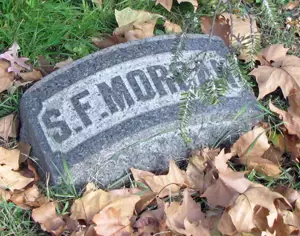
MORGAN, SANFORD (or SANDFORD) F. (1839-1872). Private, 37th Regiment, New York State National Guard, Company I. Originally from Connecticut, he enlisted as a private in 1862 and served with the 37th Regiment that year for three months. He was discharged at the end of his enlistment. The 1870 census and the 1867 and 1870 New York City Directories list his occupation as iron founder; he lived at 1026 Second Avenue in New York City. His death certificate, filed in New Jersey, reports that he was married and was an iron founder. As per his obituary in the New York Herald, he was associated with the firm of Morgan & Son in New York City. His funeral was held at his father-in-law’s residence at 224 Montgomery in Jersey City, New Jersey. Diabetes mellitus was the cause of his death. Section 187, lot 20189.
MORISON (or MORRISON), FREDERICK S. (1838-1907). Commissary sergeant, 7th Regiment, New York State National Guard, Company B. A New York City native, Morison enlisted there as a private on April 26, 1861, mustered into the 7th Regiment, New York State Militia, and mustered out with the rest of his regiment on June 3. He re-enlisted as commissary sergeant on May 25, 1862, and returned to the 7th Regiment, now part of the New York State National Guard, and was discharged with his comrades after three months on September 5In 1867, he was living at 143 West 42nd Street in Manhattan. On April 14, 1886, he mustered into the Marquis de Lafayette Post #140 of the G.A.R.; he listed his occupation as post office clerk. He died from nephritis. His last address was 214 East 53rd Street in Manhattan. Section 11/12, lot 7273.
MORONEY, GEORGE C. (1840-1871). Private, 10th New York Infantry, Company C. Originally from Ireland, Moroney enlisted at New York City as a private on January 23, 1864, and mustered the same day into Company C of the 10th New York. He served the remainder of the Civil War and mustered out at Munson’s Hill, Virginia, on June 30, 1865. His last residence was in New York City. He succumbed to consumption. Section 126, lot 5047, grave 871.
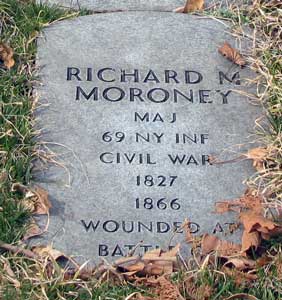
MORONEY (or MARONEY), RICHARD MORGAN (1827-1865). Major, 69th New York Infantry, Companies F and I. Moroney was born in Lockport, New York, as per New York’s Fighting Sixty-Ninth by John Mahon (2004) and other sources. He first served in the 1st New York Volunteers during the Mexican War. A machinist by trade, he lived in New York City and was active in the 69th New York State Militia. He is listed as a machinist in the New York City Directory for 1857 and in the 1860 census which also lists his personal estate as $100.
During the Civil War, Moroney enlisted as a first lieutenant on August 6, 1861, at New York City, and was commissioned into Company F of the 69th New York on October 12, 1861. The 69th was one of units in the Irish Brigade, regiments known for their valor and gallantry. He was promoted to captain on August 8, 1862, effective upon his transfer to Company I on September 12, 1862. Major James Cavanaugh of the 69th cited him in his field report from Sharpsburg, Maryland, on September 21, 1862, describing how the regiment upheld its reputation and the prestige of the flag at Antietam, “Capt[ain] Richard M. Moroney, Company I, I am proud to say, acted most bravely, cheering on [his] men, and encouraging them throughout the battle…”
He was shot in the thigh at Gettysburg, Pennsylvania, on July 2, 1863, where there are four monuments dedicated to the Irish Brigade, one honoring the three New York regiments. Moroney returned to service in August 1863. In Moroney’s report to headquarters for the summer of 1864, he described the march to Petersburg, Virginia, on June 14 and 15. The enemy was engaged on the evening of June 16 with Union forces victorious. Moroney assumed command of the Second Brigade after Vice Colonel Kelly was killed in action and subsequently commanded the First Provisional Regiment when the Second and Third Brigades were consolidated. The 69th remained in Petersburg from June 17 through July 26, 1863, building forts and doing picket duty. They then broke camp and reached Deep Bottom, Virginia, where they met the enemy on June 28, then returned to Petersburg on July 30, remaining there until August 12. On December 1, 1864, he rose to the rank of major, and mustered out on June 30, 1864, at Alexandria, Virginia.
Although his gravestone notes 1866 as the year of death, Moroney died unexpectedly on December 29, 1865. As per his obituary in the Irish American Weekly, which confirms his Civil War service, his body was found lying near the Central Railroad Depot in Richmond, Virginia; he was taken to the hospital where he died. It was assumed that he was robbed because there was no money on his person but his military discharge papers and other documents were untouched. That obituary notes that he was “esteemed by his associates as a gallant and trusty officer and a jovial companion.” His remains were brought back to New York City. According to his obituary in the New York Herald on January 4, 1866, which saluted his high reputation with the Irish Brigade, his brother officers were requested to meet at the Whitney House on Broadway and 12th Street to make arrangements for his funeral. He was buried at Green-Wood on January 7, 1866. He last lived at 39 Eldridge Street in Manhattan. In 1885, an application for a minor’s pension was filed, application 325,476, but there is no evidence that it was certified. In 2014, a post-Civil War frock coat belonging to Moroney, with his initials and the notation 69th NY, Company C, and made by the Pettibone Company was listed for sale on-line. Photos of his pistol, manufactured by Remington and pictured below, are on Ancestry.com. Section 115, lot 4196, grave 397.
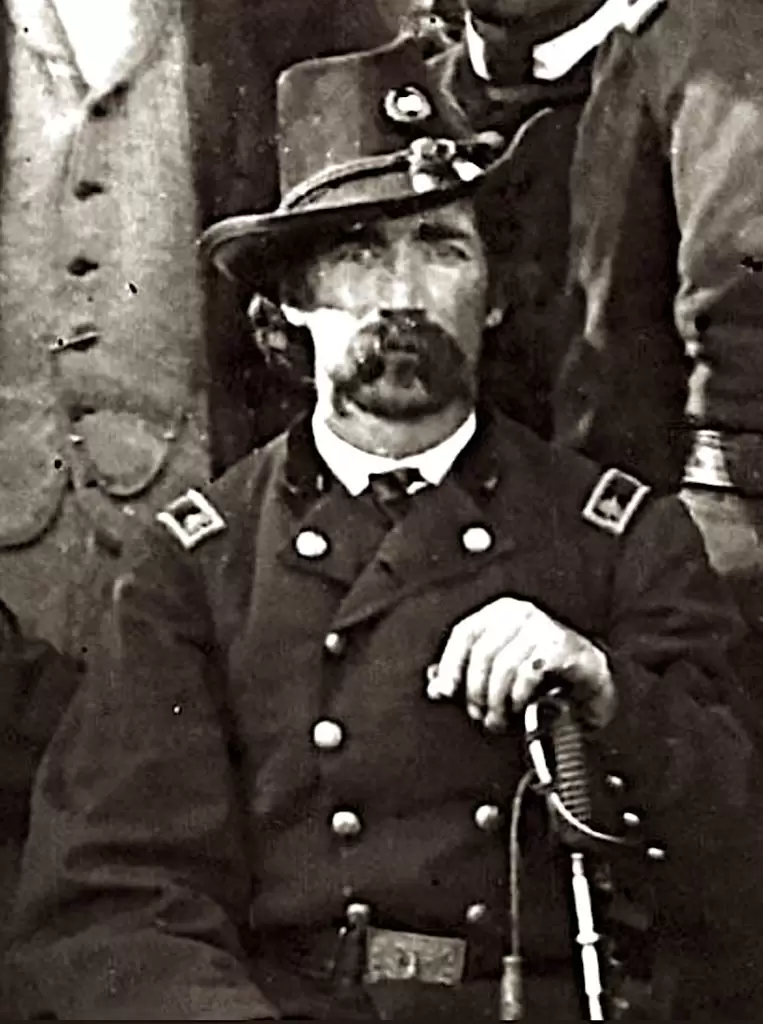


MORONG, ISRAEL (1822-1870). Private, 84th New York (14th Brooklyn) Infantry. Originally from Maine, the census of 1860 lists him as a sailor living in Brooklyn. During the Civil War, Morong enlisted as a private on September 17, 1862, at Brooklyn, but was not assigned a company when he mustered into the 14th Brooklyn two days later. As per his muster roll, he was a stevedore who was 5′ 5¾” tall with blue eyes, black hair and a dark complexion. Further details are unknown.
The census of 1870 and his death certificate indicate that he worked as a stevedore. As per his obituary in the New York Herald, he was a Freemason; friends and fellow Masons were requested to attend his funeral. His last address was in Brooklyn at the corner of Sixth Avenue and 12th Street. He died from consumption. A letter to Green-Wood Cemetery on April 12, 1905, notes that the Masonic Board of Relief paid for Morong’s burial plot on December 9, 1870. Morong had been a member of Long Island Lodge #382. Apparently, the paperwork for the gravesite was lost, his widow had died, and a receipt for the ownership of the grave was requested by Elizabeth Owen, Morong’s daughter and only child. Section 127/133, lot 17931, grave 448.
MORRELL, JOHN (1840-1921). Private, 84th New York (14th Brooklyn) Infantry, Company C; 5th New York Veteran Infantry. Morrell was born in Brooklyn and was a stonecutter’s apprentice as a young man. During the Civil War, he enlisted at Brooklyn as a private on September 30, 1861, and mustered into the 14th Brooklyn on that day. He was wounded on July 1, 1863, at Gettysburg, Pennsylvania, and transferred to the 5th New York Veteran Infantry on June 2, 1864. His muster roll notes that he was also wounded at Laurel Hill, Virginia, on May 8, 1864, was absent from the rolls on August 31, 1864, and was absent and hospitalized for wounds in New York City on October 31, 1864.
After the War, Morrell joined the police department and was connected for many years with the 14th Precinct until his retirement as a police sergeant in 1901. On July 17, 1881, the Brooklyn Daily Eagle reported on a divorce case involving Morrell and his wife, Rachel, and another couple, the Redmonds; Morrell boarded with the Redmonds while his wife and family lived in another part of town. Allegedly, Morrell and Sarah Redmond were having an affair that began in 1879. Further, to complicate matters, Mr. Redmond had intimate relations with Rachel Morrell which Rachel admitted under oath but claimed that she was an unwilling partner. Morrell left his wife and four children in September of 1879 but continued to board with the Redmonds; on August 26, 1880, Morrell and Sarah Redmond left the house. That article concludes by stating that Morrell was sent to the Raymond Street Jail in default of bail. During the period of the affair, the Redmonds were given guardianship of Charles Burrows, Sarah’s nephew, after her sister, Caroline Bailey Burrows, died; the child and the couple were listed on the census of 1880. The Brooklyn Union Argus reported on October 4, 1880, that the Redmond’s had a dispute in the street about the adopted child during which time Sarah aimed a pistol at her husband.
The October 9, 1880 Police Gazette [New York] reported that William Redmond sued Morrell for $10,000 in damages for breaking up his home and preferred charges against him in the police department. Redmond also sued Morrell for $100 for the boarding of his horse. An article on that suit which appeared in The 4 O’Clock Edition on December 2, 1880, alleged that Morrell, in addition to being sued by Redmond over his liaison, was accused of making false reports about the number of beds at the station-house and where he lived (he said the station-house); Morrell was fined three days pay. In addition, the aforementioned article noted that Sarah Redmond’s mother, Mrs. Bailey, was convinced that Morrell lived with her daughter. Sarah’s neighbor, Mrs. Roundtree, supported Mrs. Bailey and claimed that she saw Morrell’s underwear hanging on the clothesline. Morrell was given one week to prove that he lived at the station-house.
In 1897, he applied for and was granted an invalid pension, certificate 1,048,131. The 1900 census lists him as living in Brooklyn with his wife, Sarah Bailey Morrell. The 1910 census reports that he lived in Smithtown, Long Island, with his wife, Mabel Bailey Morrell. The 1915 New York State census and the 1920 census report that he was living in Queens. As per his obituaries in the Brooklyn Daily Eagle and the Brooklyn Standard Union, which confirm his Civil War service, he was a member of the Rankin Post #10 of the G.A.R. and had lived for some time in Rockville Centre, Long Island. At the time of his death from cancer, he lived at 14 Shipley Street in Woodhaven, Queens.
The Brooklyn Daily Eagle published articles on September 9 and September 11, 1921, calling into dispute the legality of Morrell’s marriage. In the first article, Rachel Morrell, 74 years old, who lived at 1015 Eighth Avenue in Brooklyn, claimed that she was Morrell’s wife and produced a marriage certificate dated October 24, 1866. She did note that the two had been separated for 42 years but had never legally divorced, thus making his current marriage illegal. Mabel Morrell’s brother-in-law claimed that Morrell had been making weekly payments to Rachel Morrell; he denied having knowledge of a divorce. In the second article, Mabel Bailey Morrell, 37 years old and Sarah’s niece, accused Rachel Morrell of “spitework” and claimed that she herself had been legally married to Morrell for 14 years. Both women applied for a widow’s pension. Rachel H. Morrell applied for and received a pension in 1921, certificate 915,837; Mabel Morrell insisted that she was the rightful widow but her pension application, also in 1921, application 1,181,673, was not certified. Section 71, lot 12187, grave 6.
MORRIS, ANDREW (1825-1876). Major, 139th New York Infantry. Morris’s birthplace is unclear; early census data lists Ireland whereas the later censuses list New York. According to the 1850 census and the 1855 New York State census, Morris was born in Ireland; the 1850 census indicates that both Andrew and his father were coopers (barrel-makers). After enlisting as a major at Brooklyn on September 9, 1862, Morris was commissioned into the Field and Staff of the 139th New York that same day, and was discharged on August 13, 1863.
During the Civil War, he met Sarah Stewart, a nurse, who became his wife in 1867. The 1865 New York State census, which lists a birthplace as Brooklyn, reports that Morris was a cooper. After his marriage, he and his wife lived in Kentucky for about five years. The 1870 census, which also lists his birthplace as New York, notes that Morris lived in Cloverport, Kentucky, with his wife and an eleven year-old girl, Mary Bosing. That census reports that he was a clerk for a coal company and had real estate worth $3,500 and a personal estate valued at $1,500. (The Victoria Coal Mines in Cloverport, named for Queen Victoria, produced cannel coal, a coal that burns without smoke, the oil of which was used to light Buckingham Palace.) The Brooklyn Directory for 1876 lists him as an inspector. As per his obituary in the Brooklyn Daily Eagle, which confirms his Civil War service, his funeral was held at St. George’s Church on Greene Avenue in Brooklyn. His last address was 810 DeKalb Avenue in Brooklyn. His death was caused by consumption.
An article in the Brooklyn Union on January 4, 1877, notes that when Morris died, he possessed about $9,000 worth of property (the equivalent of about $200,000 in 2017). He bequeathed all of his personal estate and the income from his real estate to his wife during her lifetime or while she remains a widow. The article stated, “In the event of her death or remarriage, the property is to be sold, and the proceeds are to be paid to the Treasurer of the Society for the Increase of the Ministry of the Protestant Episcopal Church in this country, one-half for the education of white persons, the other half for the education of colored men.” In 1890, Sarah Morris (see), who is interred with him, applied for and received a widow’s pension, certificate 319,450. Section 102, lot 4600.
MORRIS, ARTHUR BREESE (1809-1869). Captain and assistant quartermaster, United States Volunteers Quartermaster’s Department. Born in Morrisania, New York (named for his ancestors), Morris’s birth year is unclear. Although most records indicate 1809, his biographical sketch from the Norwich University states that he was born in 1812. According to that sketch, his genealogy traces to colonial America; his father, Lieutenant William Walton Morris was an officer during the Revolutionary War who later served on the staff of General Anthony Wayne. (William Morris is buried at the crypt of St. Ann’s Church in Morrisania, along with other members of the Morris family including Lewis Morris, a signer of the Declaration of Independence and grandfather of Arthur Morris, and Gouverneur Morris, a half-brother of Lewis Morris and a leading figure at the Constitutional Convention.)
Arthur Morris was educated at the Norwich University “Academy” from 1826 through 1829, married in 1847, and then was in the mercantile trade in New York City with his brother-in-law, Aquila G. Stout. An advertisement in the New York Evening Post on December 16, 1850, lists him as secretary of the Eagle Fire Insurance Company at 71 Wall Street; Stout was the president of the concern. He then lived in Mobile, Alabama, and was in the cotton business until the onset of the Civil War at which time he sought a position in the Army. In June 1862, a friend wrote a letter of recommendation on his behalf noting: “…he is a gentleman of extensive acquirements, large business experiences and ability, strict integrity, and undoubted loyalty; should he succeed in obtaining a position, the government will gain a most valuable and faithful servant….”
Morris’s soldier record reports that he enlisted as a captain on November 26, 1862, was commissioned into the United States Volunteers Quartermaster’s Department on that day with a same-day promotion to captain and assistant quartermaster, and was discharged on March 4, 1863, when his appointment expired. However, other handwritten documents and his sworn statement indicate that Morris officially accepted his appointment as assistant quartermaster with rank of captain on January 19, 1863, at Washington, D.C.
He returned to his work as a merchant after his duties ended; Morris is listed as a merchant in the 1870 census in a section for those who died in the previous year. He was a member of St. Paul’s Episcopal Church in Morrisania. His nephew, Francis Aquila Stout (see), the son of Morris’s sister, was a special police officer during the Draft Riots in New York City. As per his obituary in the New York Tribune, his funeral was held at St. Michael’s Church at 99th Street and Bloomingdale Road. He died at the Bloomingdale Asylum in New York City.His death was attributed to softening of the brain. After his death, there was a lawsuit about property that he owned in Minneapolis. Section 54, lot 1346.
MORRIS, ARTHUR JUDD (1817-1891). Private, 1st New Jersey Light Artillery, Battery B. Originally from Ireland, the 1850 census reports that Morris was living in Westfield, Wisconsin, with his wife and children; at that time, he was a farmer with real estate valued at $2,000. The 1855 New York State census shows him living in Brooklyn with his family; the 1860 census indicates that he lived in Williamsburg, worked as a clerk and had a personal estate of $150. During the Civil War, he enlisted at Trenton, New Jersey, on September 2, 1864, as a private. On that date, he mustered into Battery B of the 1st New Jersey Light Artillery, and mustered out of military service on June 16, 1865, at Trenton.
As per an article in The Sun on July 10, 1876, Morris was the deputy grandmaster of a procession of Orangemen (Irish Protestants) when the twenty-five lodges from Brooklyn, Williamsburg, New York and Jersey City gathered for an assembly and annual march. The men did not wear any regalia but many sported orange handkerchiefs and wore orange tiger lilies in their lapels as they marched to the Church of the Holy Trinity on Madison Avenue and 42nd Street; two policemen were in the rear of the march to provide it protection, if necessary. A member of the Erastus T. Tefft Post #355 of the Grand Army of the Republic as of January 12, 1889, Morris applied for an invalid pension in 1890, application 1,053,072, but apparently died before it was certified. Morris’s Civil War service was reported on the Veterans Schedule of 1890; however, that document lists him as a member of the New York Heavy Artillery which does not match his soldier or pension records. He may be the father of Henry O. Morris (see) who is interred in the same lot. His last address was in Baldwin, Long Island. His death was attributed to pneumonia. According to an article in the Brooklyn Standard Union on May 29, 1895, his death was memorialized at the meeting of the Tefft Post of the G.A.R. in the year that the organization celebrated its twenty-seventh birthday. Section 49, lot 7382.
MORRIS, DAVID (1832-1892). Unknown rank, 21st New York Infantry, Company I. Morris was born in Ireland. The 1860 census reports that he was a janitor. According to his pension record, he served in Company I of the 21st New York Infantry. No other details are known. Morris is listed on the 1870 census as a laborer; the 1880 census and 1884 New York City Directory list him as a porter in a store. On October 20, 1884, Morris became a naturalized citizen. He last lived at 140 Tenth Avenue in New York City; his death attributed to a homicide.
According to an article in The New York Times on April 6, 1892, he was assaulted on March 26 by a feed dealer at 134 Tenth Avenue on March 26 where Morris worked as a porter and succumbed to his injuries on April 4. As per an article in New York’s Evening World of April 5, 1892, the murder was committed by Samuel Hutchinson, his brother-in-law, who had employed Morris as a porter at the store for about sixteen years. As per the aforementioned article, there was an altercation between the two men on the evening of March 26. Morris, who had been drinking, was told by Hutchinson to turn over the keys to the store because he was in no condition to “lock up” the store; Morris refused and allegedly tried to stab Hutchinson with a pitchfork. Hutchinson then chased Morris outside, knocked him down and beat him. When Morris returned home, he was treated by two physicians. The police did not know about the incident until March 30, at which time Hutchinson was arrested. Surprisingly, one doctor told the detective that Morris was in no danger and Hutchinson was released on $1,000 bail. The night before his death, the other doctor reported that Morris was near death from his internal injuries; Morris, in the hours before his death, told the police detective that there was no reason for the assault. Hutchinson was re-arrested and claimed self-defense in light of Morris’s behavior. Susan Morris, who is interred with Morris, applied for a widow’s pension in 1912, application 989,460, but she died before it was certified. Section 135, lot 27263, grave 845.
MORRIS, GEORGE H. (1820-1873). Private, 30th New York Infantry, Company G; 76th New York Infantry, Company G. Born in New York City, Morris was a descendant of Robert Morris of Philadelphia , a financier of the American Revolution, and son of Robert Morris of Philadelphia. During the Civil War, he enlisted as a private at Saratoga Springs, New York, on August 31, 1862. On October 9, he mustered into the 30th New York, and was scheduled to be transferred into the 76th New York on May 25, 1863, but his soldier history indicates that he never joined that regiment. Morris’s muster roll notes that he was sick and in the hospital at the time of his transfer, was still sick in June 1863, and was ultimately dropped from the rolls in August 1863.
As per his obituary, in the New York Herald, he died in London, England, and was a New York City resident. His death was attributed to inflammation of the liver. His funeral was held at the Church of the Atonement at Madison Avenue and East 28th Street; friends of Morris and friends of his sister, Eliza J. Hamilton, were invited to attend his funeral. His sister was married to Jeremiah G. Hamilton, a controversial Wall Street broker and New York City’s first African-American millionaire; their inter-racial marriage spurred protesters to storm their house during the Draft Riots of July 1863—Eliza Hamilton turned the lynch mob away after saying that her husband was not at home. After Morris’s death on March 14, 1873, the Hamiltons, who had purchased a family lot at Green-Wood, arranged to have Morris’s body brought back to New York and he was interred in that lot on April 16. Section 158, lot 14972.
MORRIS, HENRY CLAY (1846-1864). Corporal, 39th New York Infantry, Company K. During Morris’s military service, the Brooklyn native enlisted there as a private on January 2, 1864, mustered into the 39th New York on that day, and was promoted to corporal on February 1, 1864. As per his muster roll, Morris was a clerk who was 5′ 7″ tall with blue eyes, brown hair and a light complexion. He died at Emory Hospital in Washington, D.C., on May 28, 1864, from battle wounds. The details of his injuries, battle site and date of death are unclear. According to one source, he was wounded in battle three times on May 6, 1864, at the Wilderness, Virginia, and died on May 18, 1864. As per his obituary in The New York Times, he was wounded at the Battle of Spotsylvania Courthouse and succumbed on May 28. The Army Record of Deceased Soldiers indicates that he was injured by “gun shot of chest involving lungs,” that “he was taken by friends,” and that he was buried at the Soldier’s Home in Washington, D.C.; the date of death on that record is May 25. According to his soldier record, he was severely wounded in the right arm necessitating amputation at Landram House (at Spotsylvania), Virginia, on May 18, 1864, and died on May 30. His obituary notes that members of the 39th Regiment and his friends and those of his late father and of his grandfather were invited to attend his funeral. Morris’s funeral took place at his mother’s residence at 337 Gold Street in Brooklyn. Section 101, lot 7502.
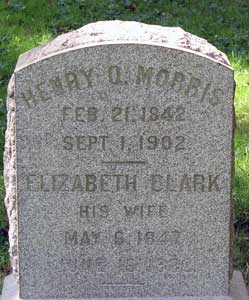
MORRIS, HENRY O. (1842-1902). Sergeant, 11th New York Cavalry, Companies B and D. Born in Ireland, according to cemetery records, Morris enlisted as a corporal at New York City on December 26, 1861, and mustered into Company B of the 11th New York Cavalry that day. As per his muster roll, he was a painter who was born in New York; he was 5′ 10″ tall with blue eyes, sandy hair and a light complexion. According to his obituary in the Brooklyn Daily Eagle, he was wounded at Fairfax Station, Virginia, in June 1863, and along with eight or nine others barely escaped capture during a charge of eighty-six men under the command of Major S. P. Remington of General J. E. B. Stuart’s Cavalry. He re-enlisted on January 2, 1864, was promoted to sergeant at some point, was transferred to Company D on July 21, 1865, and he served with that company until he mustered out on September 30, 1865, at Memphis, Tennessee.
After the Civil War, he was engaged in the printing business, on his own for some time, and at the time of his death, he worked for the Brooklyn Daily Eagle in its printing department. The obituary confirmed his status as a Union veteran of the Civil War noting his membership in the Erastus Tefft Post #355 of the G.A.R. and his participation in Encampment No. 70 of the Union Veteran Legion of which he was a past colonel. As per his obituary in the Brooklyn Daily Eagle, members of the Union Veteran Legion and comrades of his Masonic lodge were invited to attend his funeral which would take place at the home of his sister, Mrs. C. E. Whaley, at 77 Hancock Street in Brooklyn. He died from nephritis. That obituary also notes that he was a favorite in social and veteran circles. He may have been the son of Arthur J. Morris (see). His widow, Elizabeth Morris, who is interred with him, applied and received a pension in 1902, certificate 557,182. Section 49, lot 7382.
MORRIS, HENRY W. (1806-1863). Commodore, United States Navy. Morris, a native of Brooklyn, was born into a prominent family. His father, Thomas, was a lawyer who served at some point as a United States marshal for the southern district of New York, and his grandfather, Robert Morris, was a signer of the Declaration of Independence. A naval officer during the Civil War, he entered service as a midshipman on August 21, 1819, and rose to lieutenant on May 17, 1828. He served in New York City from 1839-1845 and then commanded the Southampton as part of the African Squadron. He became a commander on October 12, 1849, returned to the Brooklyn Navy Yard, and later served in the Brazilian Squadron and in the Mediterranean.
Commissioned a captain on December 27, 1856, he supervised the construction of the warship Pensacola in the Washington Navy Yard in 1861. Morris then commanded that ship past Confederate lines along the Potomac, and joined the blockade in the Gulf of Mexico. President Lincoln named Captain Morris for a special Congressional vote of thanks on May 14, 1862, for his actions in April 1862 which led to the capture of Forts Jackson and St. Philip and the city of New Orleans, Louisiana. He was promoted to commodore on July 16, 1862. After being charged with the responsibility of guarding New Orleans and its coastline, Morris found himself in failing health and returned North to regain his strength. He never returned to naval service. His last address was 55 East 12th Street in New York City where he died of gangrene. Section 35, lot 2405.
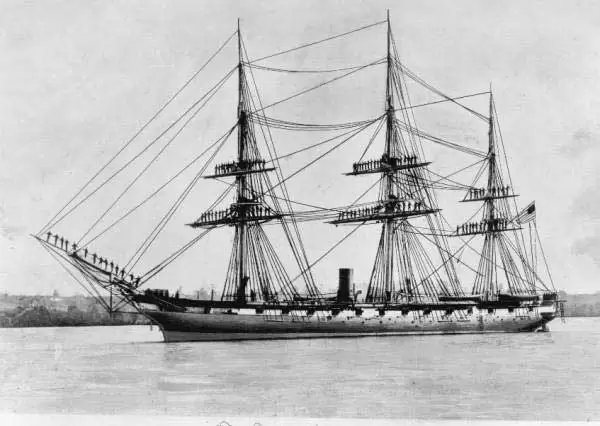
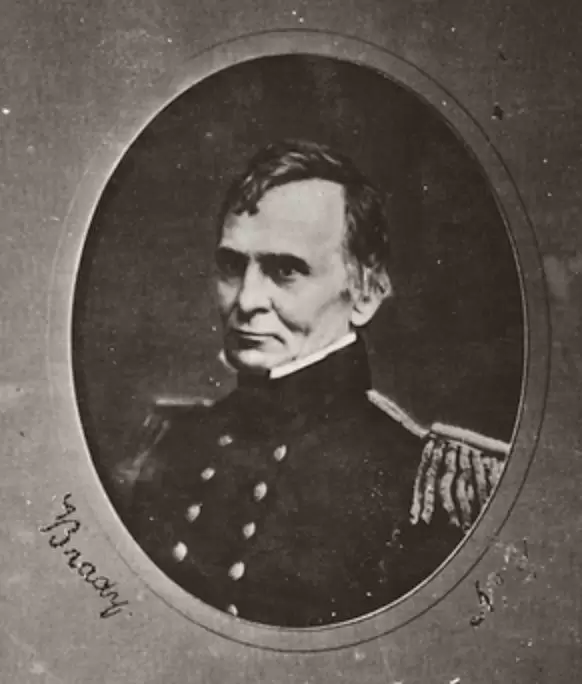
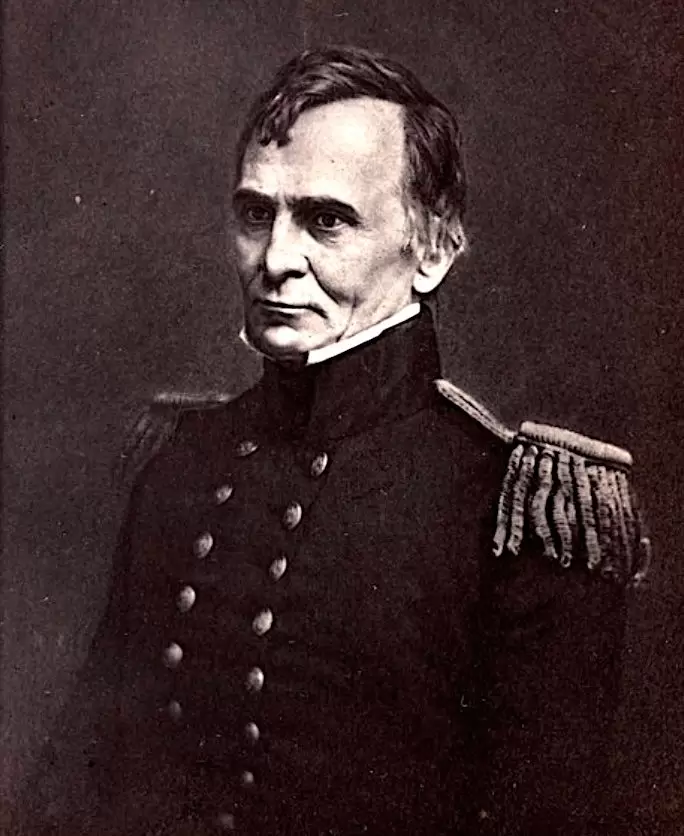
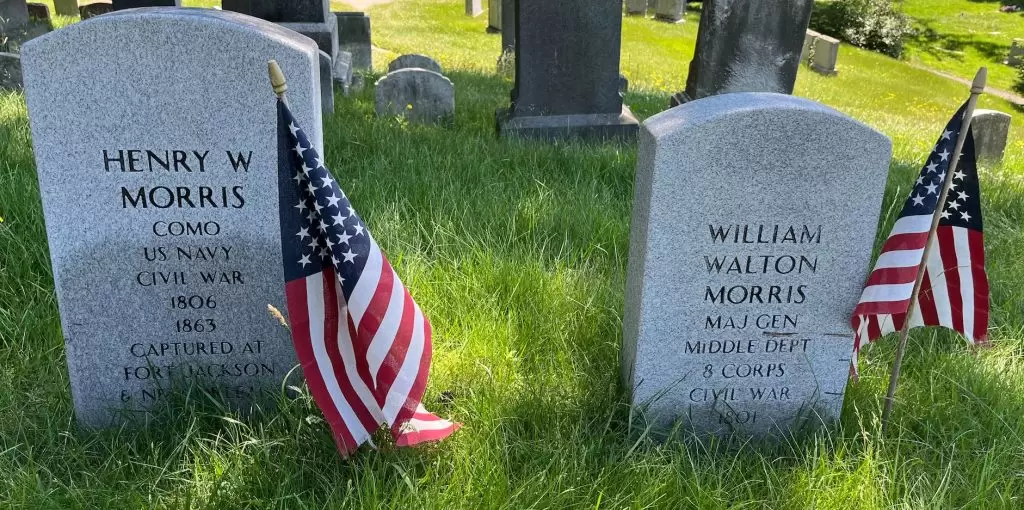
MORRIS, ORLANDO HARRIMAN (1835-1864). Colonel, 66th New York Infantry. A native New Yorker and the son of General William Morris, he graduated from Columbia College in 1854 and attended Harvard Law School. He enlisted as major at New York City on October 29, 1861, and was commissioned into the 66th New York on November 4, rising to colonel on December 12, 1862. Assigned to the 2nd Corps, he fought under General McClellan at the following Virginia battles in 1862: Fair Oaks, Gaines’ Mill, Savage Station, White Oak Swamp and Malvern Hill. He also fought at South Mountain and Antietam, Maryland, under McClellan. He commanded the regiment at the Battle of Chancellorsville, Virginia, May 1-3, 1863, in Hancock’s Division, Zook’s Brigade. He subsequently led the 66th at Gettysburg, Pennsylvania, July 1-3, 1863, where he was severely wounded, and at the Battle of Totopotomoy, Virginia, May 27-31, 1864, Barlow’s Division, Brooke’s Brigade. Colonel Morris commanded the 4th Brigade, 1st Division, 2nd Corps and was shot in the heart and killed at Cold Harbor, Virginia, on June 3, 1864. He was interred at Green-Wood on June 12, 1864. Section 23, lot 14520.


MORRIS, SARAH STEWART (1824-1909). Nurse. Sarah Morris was born in Walden, New York, and worked as a school teacher in New York City as a young woman. As per her obituary in the Brooklyn Daily Eagle, she volunteered as a nurse at the start of the Civil War, and while so working met her husband, Major Andrew Morris (see) of the 139th New York Infantry. They married at St. Andrew’s Church in Walden, New York, on September 24, 1867, and first settled in Kentucky for about five years before coming to Brooklyn. The 1870 census indicates that they lived in Cloverport, Kentucky, with an 11 year-old child, Mary Bosing; Sarah is listed as keeping house on that census. Early in the 1870s, they moved to Brooklyn. In 1890, she applied for and received a widow’s pension, certificate 319,450. Morris was a member of St. George’s Church. She last lived at 810 DeKalb Avenue in Brooklyn; her funeral was held at her residence.. Section 102, lot 4600.
MORRIS, WILLIAM WALTON (1801-1865). Major general and brigadier general by brevet; lieutenant colonel, 4th United States Artillery. Born in Ballston Springs in Saratoga County, New York, Morris was the descendant of illustrious ancestors who settled in the Morrisania section of the Bronx, named for his ancestors; he was a grandson of Lewis Morris, a signer of the Declaration of Independence. William Morris graduated from the United States Military Academy (last in his class) in 1820, then became a career Army officer, fighting Indians on the frontier in the Seminole Wars in 1836 and 1856. He also served in the Mexican War. As per his obituary in the New York Herald, he was promoted to major on November 4, 1853, and placed in command of Fort Kearny in the Nebraska Territory.
In the early days of the Civil War, as lieutenant colonel of the 4th United States Artillery, Morris was in command of Fort McHenry in Baltimore, Maryland. When Confederate sympathizers rioted there, he trained his guns on them, and restored order. He also refused to honor a writ of habeas corpus issued by a Maryland judge for a soldier in his garrison, taking the Lincoln Administration’s position that such a writ would not be honored during hostilities. The New York Herald noted that he was the first officer to obey Lincoln’s order and that this action demonstrated the firmness, deliberation and coolness that accompanied his mild manner and dignified appearance. He was brevetted brigadier general on June 9, 1862, “for meritorious service.” By order of the Headquarters Department of the East, United States Army, dated April 23, 1865, he was named a member of the Guard of Honor detailed to stand near the body of the assassinated President Abraham Lincoln as it was put on view in the City Hall of New York City. Morris was brevetted to major general in 1865 “for faithful and meritorious services,” the promotion occurring on the day before he died at Fort McHenry in Baltimore, Maryland, on December 11, 1865, while still in active service. His death was attributed to cirrhosis of the liver.
As per an article about his funeral in The New York Times on December 16, 1865, his remains were received at the Jersey City Ferry from Baltimore and were escorted to New York City Hall where he lay in state in the Governor’s Room. Morris’s coffin was made of rosewood with a sectional glass lid. He reposed in full uniform with his hat and sword alongside him and an American flag at the lower end of the coffin. The public was allowed to view his body from 10:00 a.m. until 12:15 p.m. (ending earlier than the 1:00 p.m. stated time). At 1:00 p.m., the cortege proceeded down Broadway accompanied by Police and Marine Bands, a detachment from the 17th U.S. Infantry, Morris’s horse with its saddle and other equipment covered in crepe, the carriages of family and friends, the Governor’s Island Band and the 1st United States Artillery. His funeral took place at Trinity Church in Manhattan. The streets were lined with spectators as the procession brought in the remains of the deceased. The funeral services had no musical accompaniment. Many prominent citizens and military generals were in attendance. In addition to his wife, Morris was survived by four children: one daughter and three sons– two of his sons were in the Army and one in the Navy. At the conclusion of the services, the hearse then proceeded to Green-Wood for interment.
Mary A. Morris, who is interred with him, applied for and received a widow’s pension on February 28, 1866, certificate 71,303. Section 35, lot 2405.
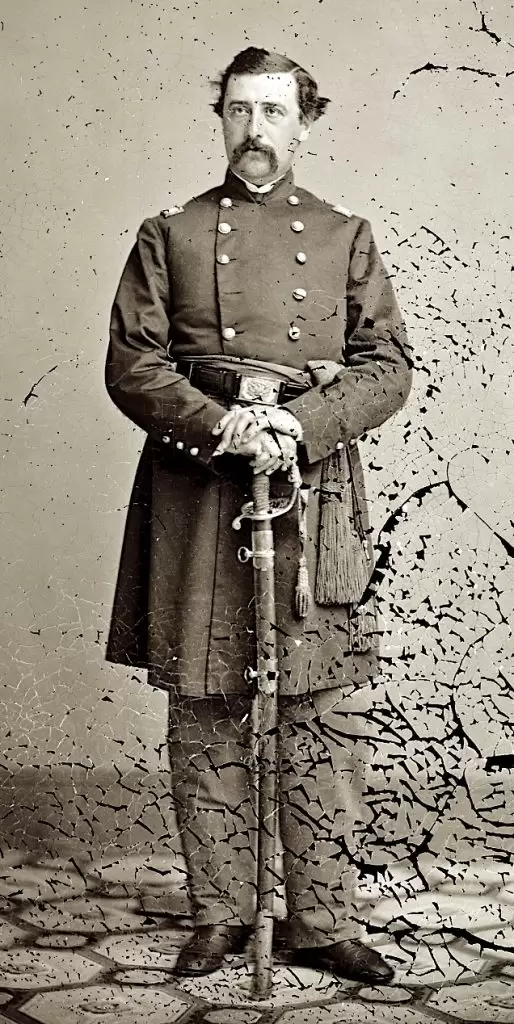
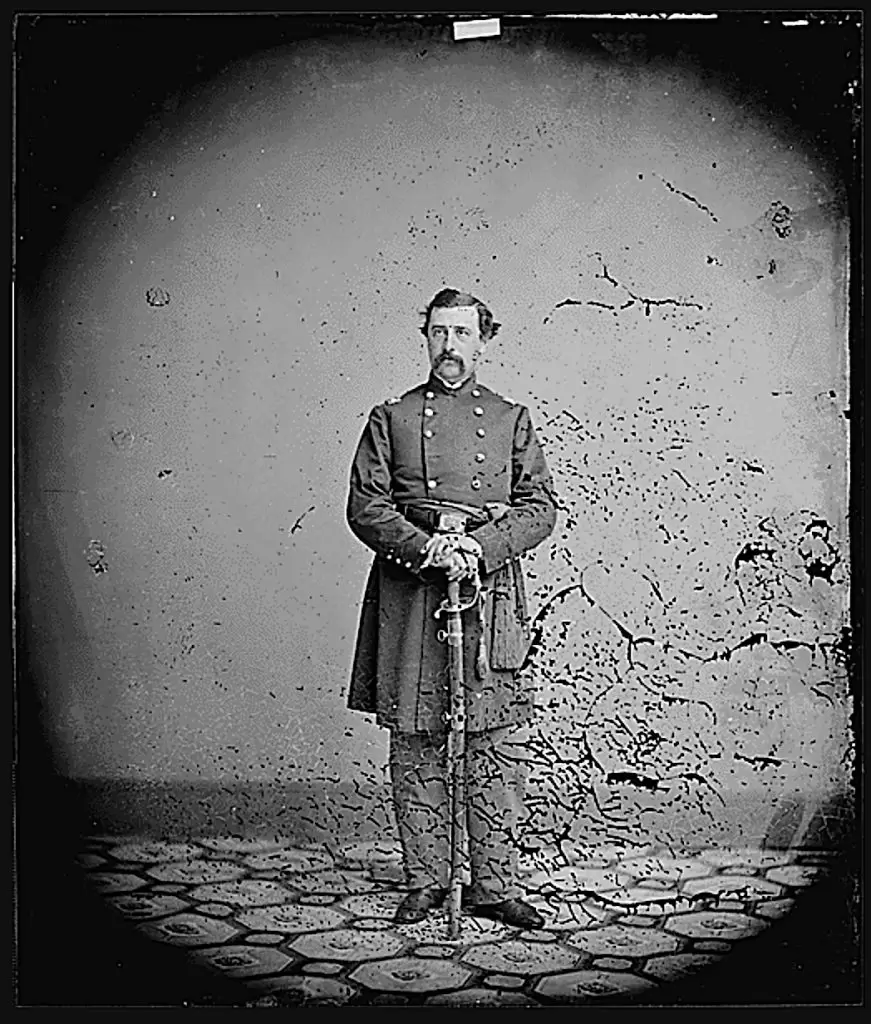
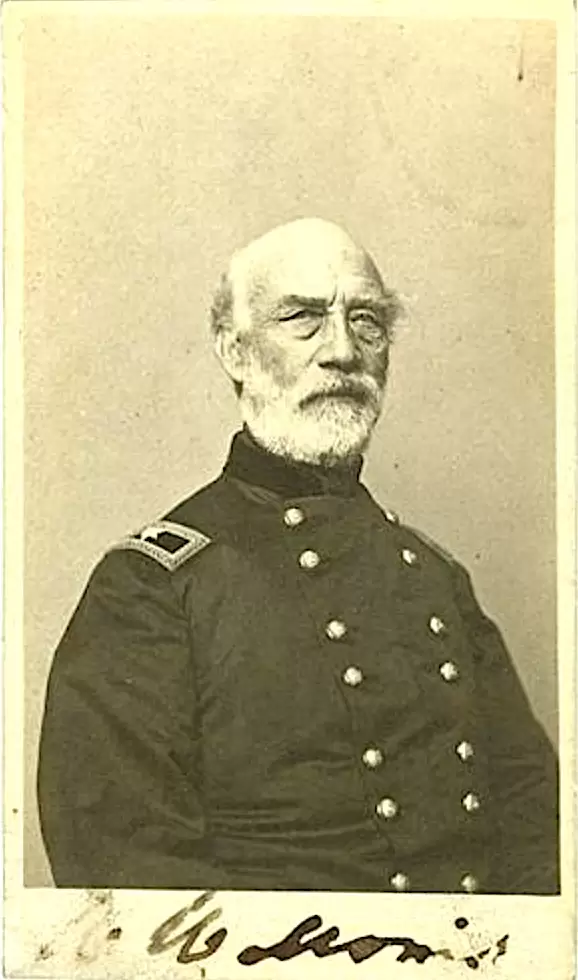
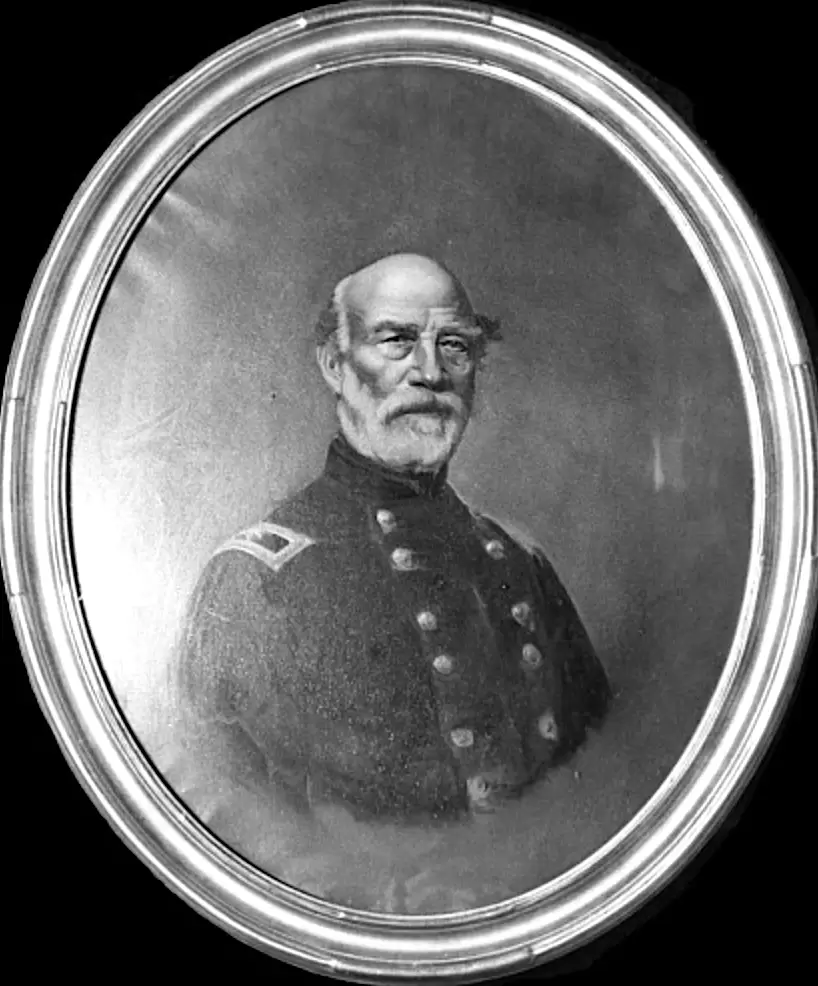
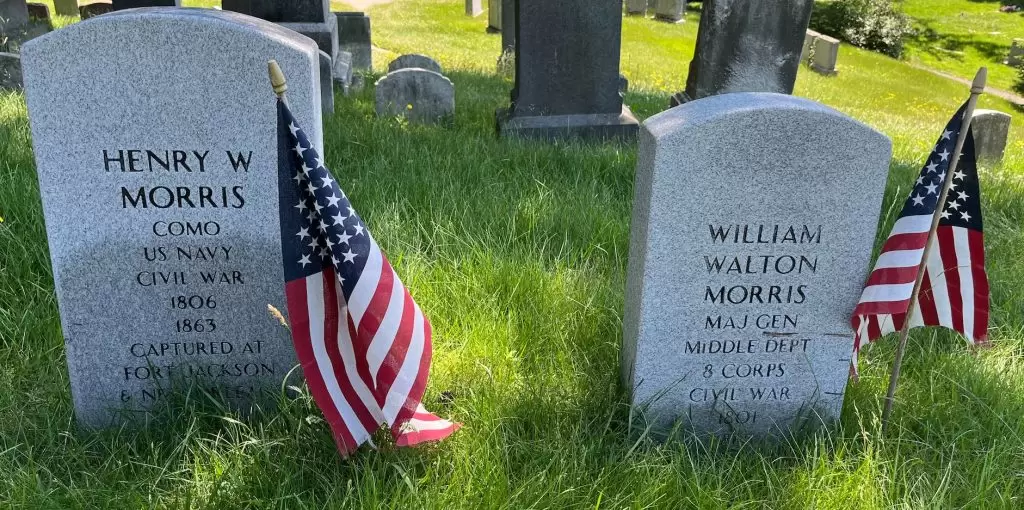
MORRISON, DAVID (1823-1896). Brigadier general by brevet; colonel, 79th New York Infantry, Company E. Born in Glasgow, Scotland, he immigrated to New York in 1842, and went into the brass manufacturing business, eventually owning his own shop. On May 28, 1861, he enlisted as a captain at New York City and was commissioned into the 79th New York, nicknamed the New York Highlanders. The 79th was assigned to the army of Major General Irwin McDowell and saw action early in the Civil War at Blackburn’s Ford and at First Bull Run, Virginia. Then, the regiment was sent to South Carolina. Morrison was promoted to major on October 21, 1861, and to lieutenant colonel on January 17, 1862. Brigadier General Isaac Stevens, United States Army, the commanding officer at Secessionville, South Carolina, on June 16, 1862, wrote about the engagement there three days later in a field report from James Island, South Carolina:
“…The firing now became general and continuous in front. The advance of the Eighth Michigan was on the parapet. The light battery of Rockwell’s was immediately pushed to the front, and took its position at the second hedge, and the Highlanders, led by [Lieutenant Colonel David] Morrison, seeing the hot fire to which the Eighth Michigan was exposed, pushed forward at the double-quick, and moving from the left to the right of the field entered a narrow opening, gained the parapet to the right of the point reached by the Eighth Michigan, and shot down the enemy whilst serving the guns…”
Morrison described the action in his field report of June 17, the bulk of which states,
“…Having proceeded about half a mile we entered a large cotton field, where I was ordered to form line of battle and charge upon the enemy’s works, and notwithstanding the ground was very unfavorable, good order was preserved. When at a distance of about 1,000 yards the guns of the fort opened upon us with canister, grape, and shell with fearful effect, and although many of my men fell, yet the regiment never faltered or wavered, but kept steadily on. Their bearing was worthy of veterans. Gallantly did they withstand the shock of musketry, and onward they pushed until they reached the ramparts. As I mounted the parapet I received a wound in the head, which, though slight, stunned me for the time being, but still I was able to retain command. With me many mounted the works, but only to fall or receive their wounds from the enemy posted in the rifle pits in rear of the fort. I ordered the right wing of the regiment to post itself behind the intrenchments (sic) at the left of the fort, which drove them back and held them in check. From the ramparts I had a full view of their works. They were intrenched (sic) in a position well selected for defensive purposes, and upon which our artillery seemed to have little effect, save driving them into their retreats, and in attempting to dislodge them we were met with a fierce and determined opposition; but with equal, if not superior, determination and courage were they met by our forces, and had I been supported, could have carried their works. One man came out from the fort and surrendered himself, and at that time had the reserve force come up could have held the fort, for we virtually had it in our possession. After remaining in this position for some considerable time and not being supported by the other regiments I received orders to fall back, which I did in good order, leaving behind about 40 killed or badly wounded, many of whom fell upon the ramparts, and brought back with me 6 killed and about 60 wounded. I was again ordered to form the regiment and advance the second time, supported by the Seventh Connecticut on the right and the One hundredth Pennsylvania on the left. We advanced in perfect order within the distance of about 600 yards, when we were ordered to halt, and the Connecticut battery on the right opened a galling fire with shot and shell, which told with wonderful effect on the enemy’s works. At this time I selected a number of my best riflemen, some of whom volunteered to advance in front of my line for the purpose of annoying the gunners inside the fort, many of whom were picked off by our men. The battery having expended their ammunition we were again ordered to fall back, which we did slowly and in good order. Nobly did the regiment sustain its former reputation and character.”
In July 1862, the 79th was assigned to the 9th Corps of the Army of the Potomac, and fought at Second Bull Run, Chantilly, Antietam, and Fredericksburg. Morrison received a promotion to colonel on February 17, 1863. In March 1863, the 79th went West serving with the Army of the Ohio at Vicksburg, Mississippi, and aiding in the defense of Knoxville, Tennessee. Morrison assumed command of the 1st Brigade, 1st Division, 9th Corps at the end of March 1863 and remained in that position until the expiration of his service. After he mustered out on May 31, 1864, at New York City, he returned to his manufacturing business. Morrison was brevetted brigadier general of volunteers on March 13, 1865, for his “gallant and meritorious conduct” at Spotsylvania Court House, Virginia, where he was wounded.
Remaining active in military affairs, he was a member of the Loyal Legion, a patriotic organization, and the Cameron Post #79 of the G.A.R. In addition, he belonged to St. Andrew’s Thistle Society and the Mechanics and Tradesman Society. His son-in-law, James Gilmour (see), also served in the 79th New York. His last residence was 43 East 65th Street in Manhattan. He succumbed to Bright’s disease. An ornate presentation sword given to Morrison on May 2, 1862, made by the Ames Manufacturing Company in Chicopee, Massachusetts, was offered for sale in the spring of 2016 for $5,250. Section 153, lot 20179.
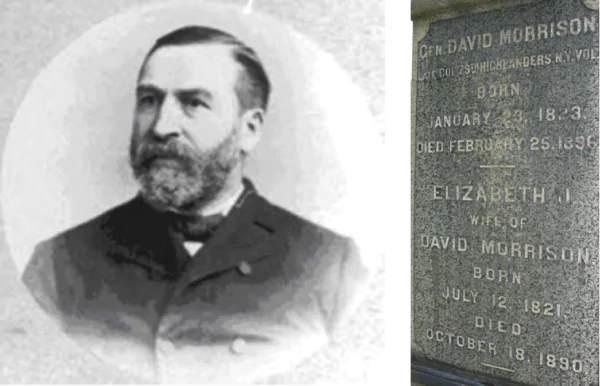
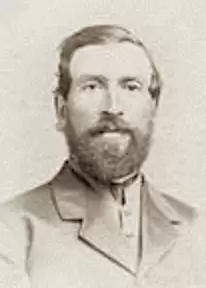
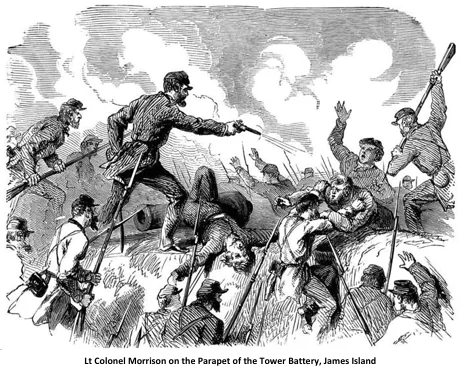
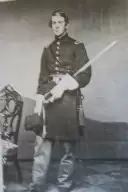
MORRISON, GARDNER (or GARDINER, G. L.) LANDON (1842-1895). Major by brevet; second lieutenant, 4th New York Heavy Artillery, Battery B. Morrison was born in Brooklyn. At the time of the 1850 census, Morrison was living in Troy, New York, with his parents and grandparents; both his father and grandfather were in the stove business (heating and parlor stoves). The 1855 New York States census reports that he was living in Albany, New York, where his father had an iron foundry.
After enlisting as a second lieutenant on October 7, 1861, Morrison was commissioned into the 4th New York Heavy Artillery the next month on November 1. As per his muster roll, he was a clerk who was 5′ 9″ tall with blue eyes, brown hair and a fair complexion. In August 1863, he was an acting assistant inspector general. He mustered out on October 11, 1864, at Petersburg, Virginia. “Gallant and meritorious service in the late War” earned him a promotion by brevet to major. Morrison’s pension index card also indicates service in Battery M of the 4th Heavy Artillery.
Morrison’s marriage to Anna Clover was announced in the New-York Daily Tribune on June 12, 1869. According the 1870 census, he was living with his wife and his mother’s family in Brooklyn; he was a clerk in the stove business. The 1880 census indicates that he lived in Brooklyn and was a stove dealer; he is listed as working in stoves in the Brooklyn Directories for 1883 and 1887. In May 1888, he mustered into the G.A.R. and was a member of the George C. Strong Post #534. By 1890, he had secured numerous patents for mantel stoves; his work was for heating and parlor stoves, following in the footsteps of his father and grandfather. The 1891 Brooklyn Directory lists him as a superintendent and salesman.
According to an article in the Brooklyn Daily Eagle on January 11, 1891, he was the outgoing master of the Irving Lodge No. 307, of the Ancient Order of United Workmen, a fraternal benefit society. At that meeting, he thanked the members for their courtesy during his time in office. A subsequent article in the Brooklyn Daily Eagle on March 22, 1891, notes that he was present at an encampment of the Union Veteran Legion and had just been elected as its lieutenant colonel. Active in the G.A.R.’s Strong Post, the Brooklyn Daily Eagle reported on May 22, 1892, that Junior Vice Commander Morrison would command his comrades at Memorial Day ceremonies at Cypress Hills and Evergreen Cemeteries. At the time of his death, he resided at 184 Herkimer Street in Brooklyn. His death was attributed to pneumonia. Notice of his obituary was forwarded to papers in Troy, New York. In 1895, Anna (Annie) Morrison, who is interred with him, applied for and received a widow’s pension, certificate 426,207. Section 177, lot 16257.
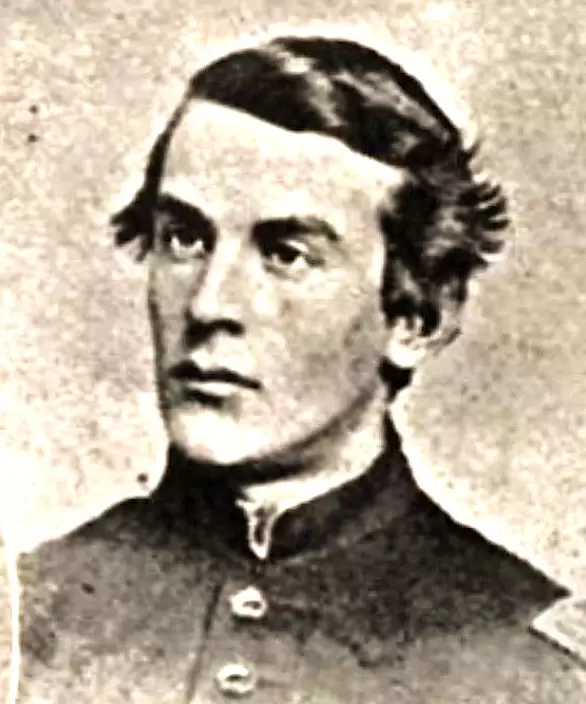
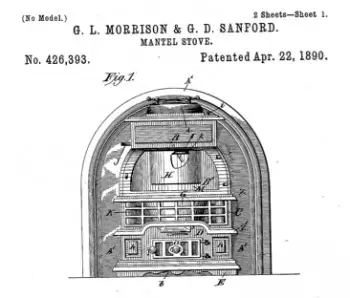
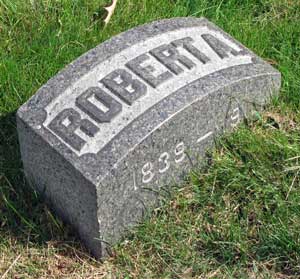
MORRISON, ROBERT A. (1839-1911). Sergeant, 1st New York Engineers, Companies H and A; 1st Battalion United States Engineers, Company C. Born in New York City, Morrison lived there with his parents as per the census of 1860; at that time, he worked as a clerk. During the Civil War, he enlisted as a private first class on February 11, 1862, and mustered into Company H of the 1st New York Engineers on that day. According to his muster roll, which lists his occupation as soldier, he was 5′ 6″ tall with grey eyes, brown hair and a fair complexion. He was promoted to artificer on July 1, 1862. Morrison re-enlisted as an artificer on February 13, 1864, and mustered into the 1st Engineers on March 11. His muster roll notes that he was promoted to corporal on September 16, 1864, to sergeant on May 1, 1865, and mustered out with his company on June 30, 1865. According to the pension index at the National Archives, he also served in Company A of the 1st Engineers and Company C, 1st Battalion, United States Engineers.
The 1880 census notes that Morrison was single, worked as a clerk and lived with his parents. On February 3, 1888, he mustered into the Lafayette Post #140 of the G.A.R.; at that time, he was a clerk who lived at 533 Bedford Avenue in Brooklyn. Morrison is listed in the 1889 Brooklyn Directory as working in telegraph supplies; the 1891 Brooklyn Directory states that he was employed in railroad supplies. Morrison is listed in the Veterans Census of 1890 but there is no mention of his Civil War service. He applied for and received a pension in 1904, certificate 1,088,878. The 1910 census notes that Morrison was a jewelry collector and had been married for twenty-three years. As per his obituary in the Brooklyn Daily Eagle, members of the Lafayette Post were invited to attend his funeral. His last residence was at 87 Hamilton Place, Manhattan. Shortly after his death from Bright’s disease in 1911, Lillie (Lollie) Morrison applied for and received a widow’s pension, certificate 728,659. Section 107, lot 896.
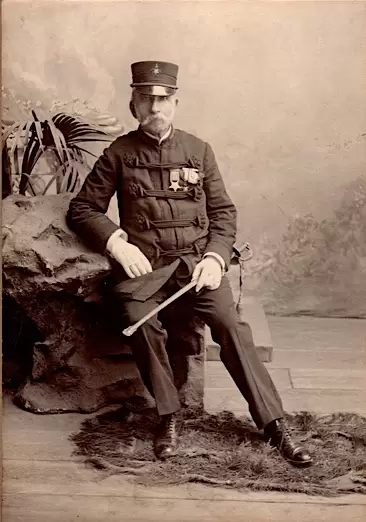
MORRISON, ROBERT A. (or W.) (1844-1907). Private, 23rd Regiment, New York State National Guard, Company G. Morrison was born in New York City and, at age seven, settled in Brooklyn with his family. First educated in the public schools, he later studied at Wheeler’s Academy. As per A History of Long Island by Peter Ross (1902), Morrison first tried to join the 14th Regiment of the New York National Guard during the Civil War but was refused because he was only seventeen. However, a year later, he joined the 23rd Regiment and served for eight years. First, he did guard duty in General Francis B. Spinola’s (see) Brigade in East New York in 1862. His soldier record reports that Morrison served as a private for 30 days in Company G the 23rd Regiment in 1863. The 23rd Regiment was called up on June 16, 1863, to help meet Robert E. Lee’s Army of Northern Virginia as it marched into Pennsylvania, left for Harrisburg, Pennsylvania, on June 18 and was attached to the 3rd Brigade, 1st Division, Department of the Susquehanna. The 23rd saw action at Oyster Point, Pennsylvania, on June 28, and at Carlisle, Pennsylvania, on July 1, before mustering out on July 22, 1863. Ross notes that during the Draft Riots of July 1863, Morrison was stationed at the Atlantic docks.
According to the Brooklyn Daily Eagle, he was admitted to the bar in 1866 (although Ross’s biography says 1867) and was a well-known lawyer at the Arbuckle Building. Morrison’s specialty was civil law and he had a large clientele. A Democrat, he was a member of the Andrew Jackson Club and the Brunswick Democratic Club. The 1880 census reports that he was living with his in-laws; the 1900 census, which incorrectly lists his birth year as 1845, indicates that he was married, living in Brooklyn, and employed as a lawyer. As per his obituary in the Brooklyn Daily Eagle, he was a member of the Veterans Association of the 23rd Regiment, the Winchester Post # 197 of the G.A.R., the Society of Old Brooklynites, the Elks, and was a Freemason; members of his Masonic lodge were invited to attend his funeral at the Protestant Church of the Nativity in Brooklyn. At the time of his sudden death, he had been a Brooklyn resident for fifty-seven years and had been married for thirty-nine years. He last lived at 71 Kenilworth Place in Brooklyn. Section 48, lot 6366, grave 3.
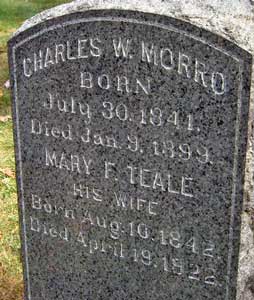
MORRO, CHARLES W. (1841-1899). Sergeant, 103rd New York Infantry, Company D. Morro was born in Cologne, Germany. After enlisting as a corporal at New York City on January 31, 1862, he immediately mustered into the 103rd New York. Morro was promoted to sergeant at some point but deserted on December 13, 1862, at Fredericksburg, Virginia.
The 1870 and 1880 censuses list him as married and living with his in-laws, the Teales. In 1870, Morro worked as a bookkeeper; the 1878 Brooklyn Directory reports that he was a clerk and the 1880 census indicates that he was a salesman. The Brooklyn Directories for 1891 and 1898 list him as a salesman. As per his obituary in the Brooklyn Daily Eagle, he died after a brief illness, the grippe (influenza). He last lived at 377 Van Buren Street in Brooklyn. Section 43, lot 6513.